 23/05/2009 01:30 23/05/2009 01:30 |
|
| | | OFFLINE | | Post: 17.503
Post: 211 | Registrato il: 28/08/2005
Registrato il: 20/01/2009 | Administratore | Utente Junior | |
|

 See preceding page for stories posted earlier today.
See preceding page for stories posted earlier today.

 Relations warming up between
Relations warming up between
Russian Orthodox Church and Vatican
By SOPHIA KISHKOVSKY

Published: May 22, 2009
MOSCOW — Festivities in Rome this weekend for the dedication of an Orthodox church on the grounds of the Russian Embassy near the Vatican attest to a surprising but marked warming of relations between the Russian Orthodox Church and the Vatican in recent months, according to church officials and analysts.
If trends hold true, they add, a meeting of the Pope and the Patriarch of the Orthodox Church in Russia may be close. Whether even that could begin to overcome the centuries-old hatred surrounding the two Churches’ conflicting authority over Christians is another question.
[But what a mistaken statement about the divergence between the two Churches! It's not about who has authority over Christians, but about the primacy of Peter in a reunified Christianity where the different member Churches will remain autonomous as they now are, and therefore under the authority of their respective local Patriarchs in the case of the Orthodox Churches. That question is the main sticking point of the theological 'reconciliation' being undertaken by a Mixed Catholic-Orthodox Commission, which agreed last year to study it in the light of the history of the first Christian millenium before the Great Schism of 1046.]
To mark the dedication Sunday of the Church of St. Catherine the Great Martyr, Orthodox clergy will conduct a prayer service Saturday at the Church of San Clemente, and the choir of the Danilov Monastery, the seat of the Moscow Patriarchate, will sing in a Roman basilica.
Pope John Paul II long dreamed of visiting Russia and mending relations with its Orthodox church, the world’s largest. But the Pope’s Polish origins apparently heightened the suspicions of Russian church leaders about his intent, and he was neither invited to Russia nor able to overcome tensions about the Uniate Church [in the Ukraine, not in Russia], which follows the Eastern rite but is loyal to Rome, and about Catholic priests [accused of] prosyletizing here.
After John Paul’s death, and the election in January of Patriarch Kirill as the new head of the Russian Orthodox Church, relations have warmed.
In March, Pope Benedict XVI, a German, sent a message to a ceremony in Bari, Italy, where the Italian government handed back to Russia a church and pilgrimage center built in the czarist era.
“How could we not recognize that this beautiful Church awakens in us the nostalgia for full unity and maintains alive in us the commitment to work for union among all the disciples of Christ,” Benedict wrote.
Reflecting Russia’s geopolitical dance with Europe, the Moscow Patriarchate has found common ground with Benedict, and since Patriarch Kirill was enthroned, he has appointed Church officials who portray the Pope as a like-minded man of the Church, not of politics.
“This Pope, in contrast to the previous one, doesn’t strive to always be politically correct [an unnecessarily unkind statement, I think, about John Paul II as though he had dubious motives]”, said Archbishop Hilarion of Volokolamsk, an Oxford-educated theologian who was until recently the Russian Orthodox Bishop of Vienna and Austria and the Russian Church’s representative to European institutions.
“He believes he must speak of the teachings of the Catholic church. The task of such a Church figure, especially of such rank, is to clearly state the teaching of the Church, even if it doesn’t correspond to contemporary standards of political correctness.”
Archbishop Hilarion was selected in March to lead the patriarchate’s Department of External Church Relations, which Patriarch Kirill headed for two decades.
Both Archbishop Hilarion and the Reverend Vsevolod Chaplin, another rising Church official in his early forties who heads a newly created department on Church and society relations, strongly backed Benedict’s controversial comments in March that condoms are not the solution to the spread of AIDS. Their voices were among the few supporting Benedict’s stand [Not counting, that is, all the scientists and AIDS experts with years of experience in Africa who pointed out how data over the past decade back the Pope's contention! Typical MSM trick to perpetrate their misrepresentations.]
From Rome come indications that Patriarch Kirill’s election represents a new chance for Russian Orthodoxy.
His predecessor, Patriarch Aleksy II, “had to work to refound the Vhurch, to set up structures, organize the clergy” after Soviet power crumbled, said Monsignor Bruno Forte, archbishop of Chieti-Vasto and a member of the Joint International Commission for the Theological Dialogue between the Roman Catholic Church and the Orthodox Church. “Kirill has been handed a reborn Church, so he has the strength to forge a new path.”
As Metropolitan of Smolensk in 2006 [and head of the Church's Foreign RElations department], Patriarch Kirill wrote the foreword to the first Russian-language edition of Pope Benedict’s book Introduction to Christianity, written when he was still the theologian Joseph Ratzinger.
He wrote: “The traditionalism of Benedict XVI offers a profound view, a wise insight into the essence of things. It is my deep conviction that this must be the approach of all Christians desiring to remain loyal to the never-aging Tradition of the Ancient Church in the face of the latest in a series of onslaughts of totalitarian relativism, which we are observing today.”
Ironically, while conservative values unite the new Patriarch and Benedict, Patriarch Kirill has been under attack by Russian Orthodox fundamentalists, in part for an outgoing style and presence that more readily recall John Paul II.
Tensions between Moscow and some of the world’s Orthodox churches are a stumbling block to relations with the Roman Catholic Church.
Moscow and Constantinople have been wrestling for centuries over jurisdictional issues, and with renewed vigor since the collapse of the Soviet Union.
On the issue of primacy, the Moscow Patriarchate chafes especially when the Patriarch of Constantinople is described as the leader of the world’s Orthodox Christians, and when that Patriarch is compared with the Pope.
The Russian Church, said Archbishop Hilarion, would like to promote the role of Orthodoxy in the European Union. “Now several Orthodox states are part of the European Union,” he said, alluding to Bulgaria, Romania and Greece.
All this has experts saying that a meeting of Pope and Patriarch is now much more likely, if hard to predict. “Patriarch Kirill is unpredictable,” said Aleksei Yudin, a member of the editorial board of the Russian Catholic Encyclopedia. “He might have some powerful move. If a goal appears, he won’t be slow.”
Elisabetta Povoledo contributed reporting from Rome.
[Modificato da TERESA BENEDETTA 23/05/2009 01:40] |
| |
|
| |
 23/05/2009 11:54 23/05/2009 11:54 |
|
| | | OFFLINE | | Post: 17.505
Post: 212 | Registrato il: 28/08/2005
Registrato il: 20/01/2009 | Administratore | Utente Junior | |
|
 GREETING TWO SLAVIC PRESIDENTS
GREETING TWO SLAVIC PRESIDENTS
IN ROME TO HONOR ST. CYRIL
The Holy Father today received the Presidents of Bulgaria and Macedonia in separate audiences Friday, May 22, at the Vatican. They are both in Rome to attend the annual manifestation Saturday in honor of St. Cyril who is buried in the Church of San Clemente in Rome.
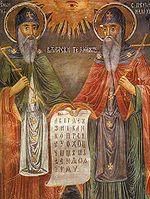
Cyril and Methodius were Byzantine Greeks from Thessalonia who became Christian missionaries to the Slavic peoples in the 9th century. Cyril died in Rome in 869,and his older brother Methodius lived another 16 years.during which he continued their mission in Slavic lands, dying in Moravia in 1885. They were credited with devising the alphabet that became the basis for the Cyrillic alphabet used in all the Slavic countries including Russia.
They are venerated in the Eastern Orthodox Churches as 'Equals to the Apostles', and in 1980, Pope John Paul II named them Co-Patrons of Europe along with St. Benedict of Nursia. Cyril is the patron saint of Bulgaria, while Macedonia has observed an annual manifestation for St Cyril in Rome for the past 40 years.
Both Presidents were accompanied by their top Orthodox prelates.
WITH THE BULGARIAN PRESIDENT


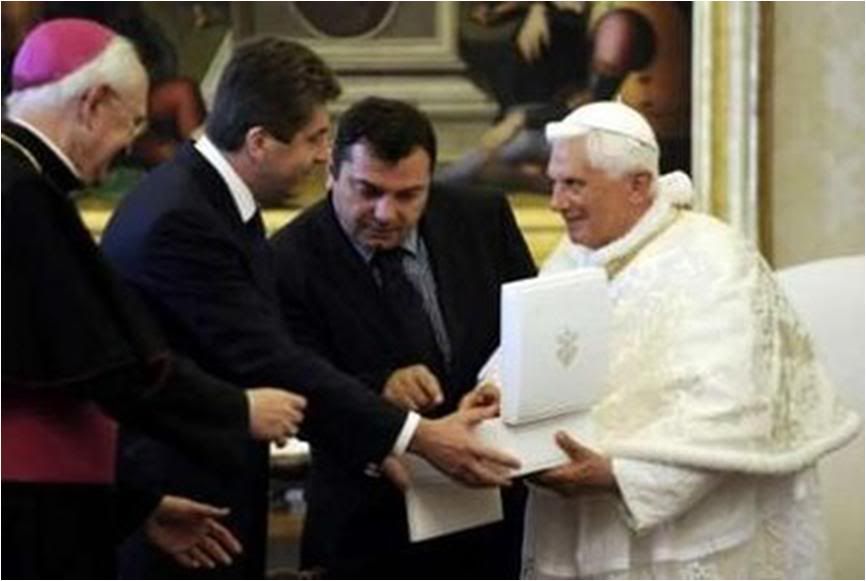
Here is a translation of the Holy Father's address to President Georgi Parvanov of Bulgaria, delivered in French:
Mr. President,
Ladies and gentlemen members of the government delegation,
Venerated representatives of the Orthodox Church and the Catholic Church,
I am particularly pleased to extend to each of you my most heartfelt greetings at this encounter which takes place at the annual celebration in honor of Saints Cyril and Methodius. Ont his joyous occasion, I wish to renew mys sentiments of friendship for teh beloved Bulgarian people whose spiritual roots - as your visit today gives witness - go back to the preaching of the Saints who are co-Patrons of Europe.
I greet each of you with deference and I extend t4his to the Bulgarian authorities and all Bulgarians, as well as to the pastors and the faithful of the Orthodox Church and the Catholic Church in your beloved country.
This meeting allows us to think once again of the evangelical and social work realized by those two distinguished witnesses to the Gospel, Saints Cyril and Methodius.
Their spiritual heritage has stamped the Slavic peoples. Their example has sustained the witness and fidelity of numberless Christians who, through the centuries, consecrated their existence to spreading the message of salvation while working to build a just and fraternal society.
May their spiritual witness remain alive in your nation so that Bulgaria, availing of this source of light and hope, may contribute effectively to constructing a Europe that stays faithful to its Christian roots.
The values of solidarity and justice, of freedom and peace, reaffirmed constantly today, find even greater force and solidity in the eternal teachings of Christ, translated in the lives of his disciples in all eras.
These are the sentiments which I wish to manifest to each of you, assuring you of my esteem and spiritual closeness. Be sure that the Holy See continues to follow with sympathy the course of your nation and the involvement of all those who work for its good.
From my heart, I invoke on each of you the abundance of divine bklessings.
WITH THE MACEDONIAN PRESIDENT
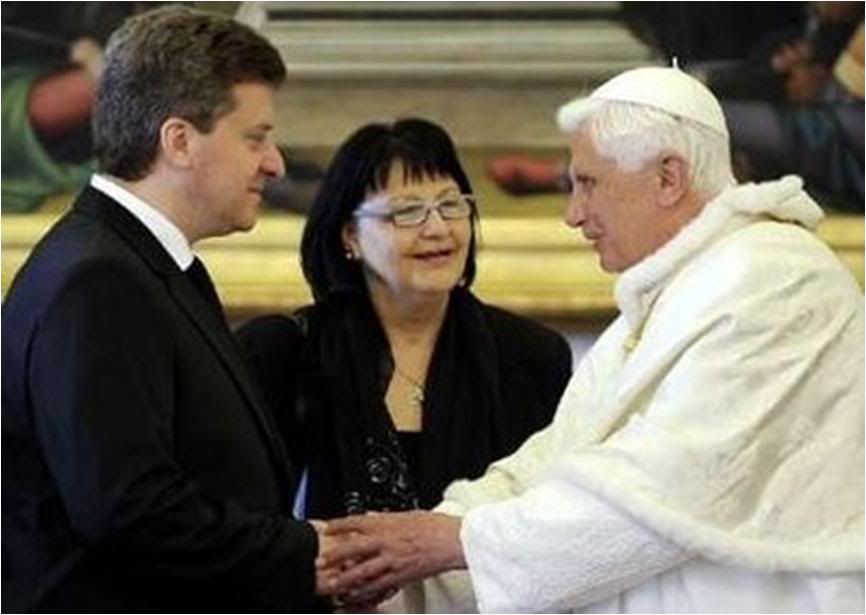
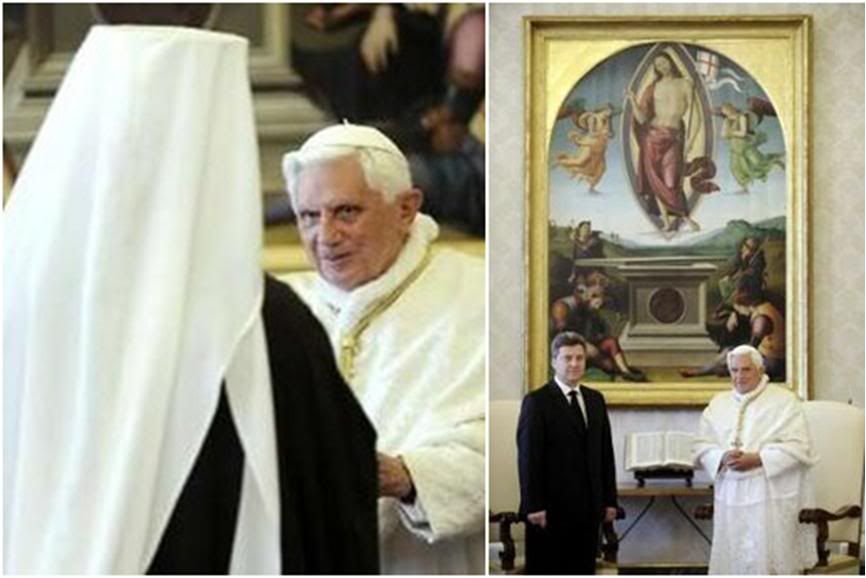
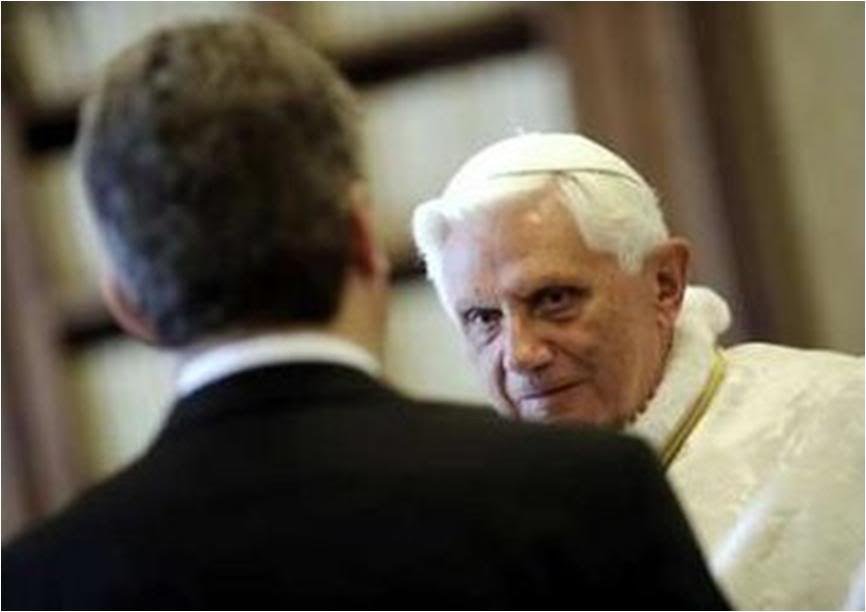
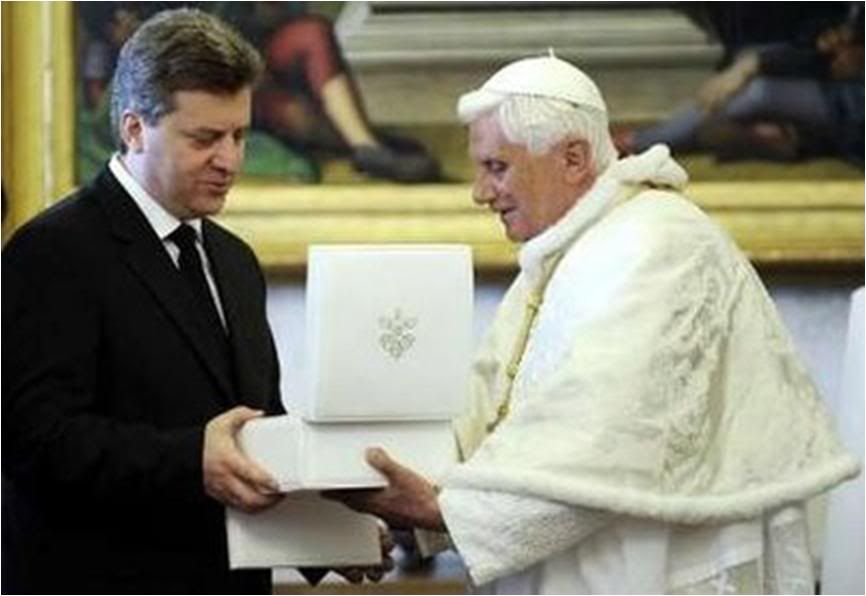
A Macedonian news agency reported that President Gjeorge Ivanov invited the Pontiff to pay a visit to Macedonia in 2010 to mark the 100th anniversary of the birth of Mother Teresa in her hometown of Skopje [she was Albanian by nationality but was born in Macedonia].
Here is the text of the Pope's greeting to President Ivanov, delivered in English:
Mr President.
Honourable Members of the Delegation,
Venerable Brothers of the Orthodox Church and of the Catholic Church!
I am happy to welcome you again this year on the liturgical memorial of Saints Cyril and Methodius. I am pleased that during your visit to pay homage to the Co-Patrons of Europe you have expressed the desire to meet with me, an occurrence that has already become a tradition.
I thank you for this courteous gesture and I extend to each one of you my heart-felt welcome and my appreciation for the sentiments that you bring to this gathering.
I express a special welcome to the authorities and to all the population of the Former Yugoslav Republic of Macedonia. I also send particular greetings to the faithful and to those who have pastoral responsibilities in your country.
I avail myself of the occasion to express the sentiments of esteem and friendship that unite the Holy See to the beloved Macedonian people.
The annual celebration of the feast of Saints Cyril and Methodius, teachers of the faith and apostles of the Slavonic peoples, invites all of us who are united by the one faith in Jesus Christ, to contemplate their heroic evangelical witness.
At the same time we are challenged to conserve the patrimony of ideals and values that they have transmitted by word and deed. In fact this is the most precious contribution that Christians can offer to the construction of a Europe of the third millennium, which aspires to a future of progress, justice and peace for all.
Your beloved homeland, marked by the influence of these two great saints, seeks to become more and more a place of peaceful encounter and dialogue between the country’s many social and religious spheres.
My hope, which I renew today with all my heart, is that you may continue to progress on this path. As I invoke divine protection upon the authorities of your nation, to whom I renew the closeness of the Apostolic See, I wish to assure you of my personal esteem and friendship.
Once again I extend my warm good wishes to each one of you on this Feast-day and offer fervent prayers to the Lord both for you who are present here today and for all the Macedonian people.
[Modificato da TERESA BENEDETTA 27/05/2009 08:17] |
| |
 23/05/2009 14:21 23/05/2009 14:21 |
|
| | | OFFLINE | | Post: 17.506
Post: 214 | Registrato il: 28/08/2005
Registrato il: 20/01/2009 | Administratore | Utente Junior | |
|

May 23
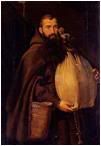 St. Felix of Cantalice (Italy, 1515-1587)
St. Felix of Cantalice (Italy, 1515-1587)
Franciscan lay brother and reformer
Companion to St. Philip Neri
OR for 5/22-5/23:
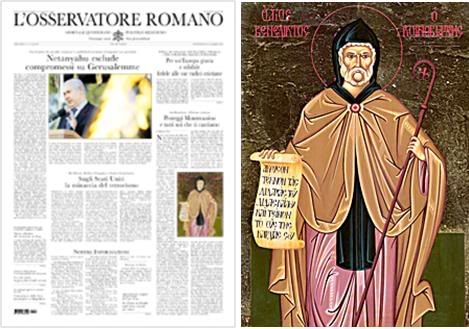
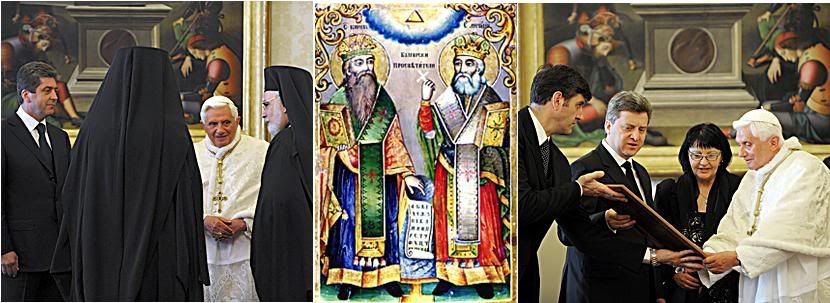 The papal story on Page 1 is about the Pope's meeting with the Presidents of Bulgaria (left photo above) and Macedonia (right photo above) who are in Rome to honor Saints Cyril and Methodius (see story in the post above), and there is a story on St. Benedict, who like the brother saints, is a Patron of Europe, and whom Benedict XVI honors tomorrow by his pastoral visit to Cassino and Montecassino. The main Page 1 news story is a statement by Israeli PM Netanyahu that Israel cannot compromise on Jerusalem which it claims as the 'eternal and undivided capital' of Israel; and a story on opposing approaches to terrorism in the United States.
THE POPE'S DAY
The papal story on Page 1 is about the Pope's meeting with the Presidents of Bulgaria (left photo above) and Macedonia (right photo above) who are in Rome to honor Saints Cyril and Methodius (see story in the post above), and there is a story on St. Benedict, who like the brother saints, is a Patron of Europe, and whom Benedict XVI honors tomorrow by his pastoral visit to Cassino and Montecassino. The main Page 1 news story is a statement by Israeli PM Netanyahu that Israel cannot compromise on Jerusalem which it claims as the 'eternal and undivided capital' of Israel; and a story on opposing approaches to terrorism in the United States.
THE POPE'S DAY
The Holy Father met today with
- Cardinal Ivan Dias, Prefect of the Congregation for the Evangelization of Peoples
- Bishops of Peru (Group 6) on ad-limina visit
- Mons. Beniamino Stella, President of the Pontifical Ecclesiastical Academy, and members of the Academy.
Address in Italian.
POPE URGES FUTURE VATICAN DIPLOMATS
TO BE MEN OF PRAYER ABOVE ALL

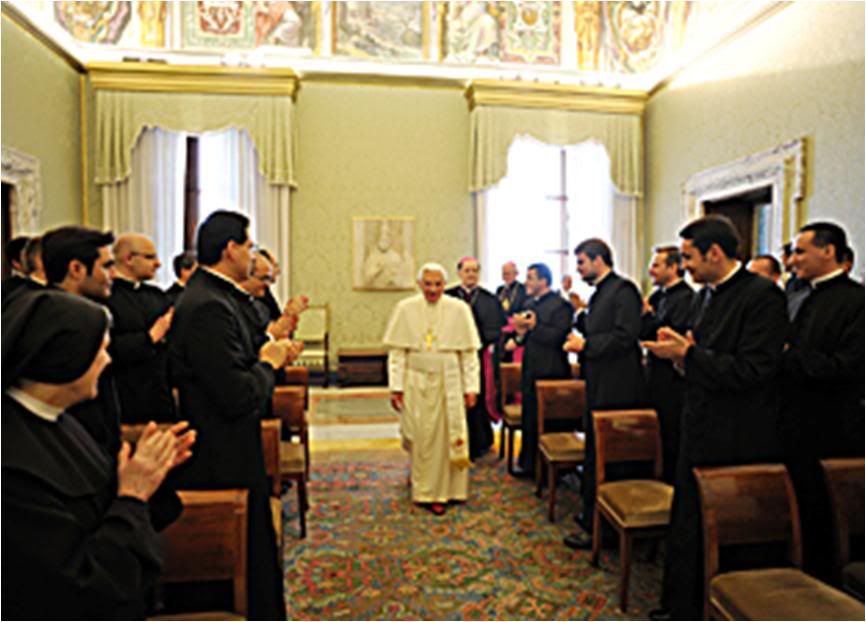
VATICAN CITY (Zenit) - Vatican diplomats should have spiritual strength in order to dialogue with the modern world while safeguarding their Christian and priestly identity, Benedict XVI told members of the Pontifical Ecclesiastical Academy Saturday, May 23.
The academy is responsible for training candidates for the Holy See diplomatic service, and the Pope met with its students at the Vatican and the academy president, Archbishop Beniamino Stella.
The Pontiff said that the students' upcoming service in various apostolic nunciatures may "be considered as a specific priestly vocation, a pastoral ministry that involves a particular approach to the world and to its often highly complex social and political problems."
He continued, "The dialogue with the modern world that is asked of you, as well as your contact with people and the institutions they represent, require an inner strength and a spiritual firmness capable of safeguarding -- indeed of giving ever more prominence to -- your Christian and priestly identity."
The Holy Father explained that this is necessary so as to avoid "the negative effects of the worldly mentality" and to keep from being "attracted or contaminated by an overly earthly logic."
"In moments of darkness and inner difficulty," he said, "turn your gaze to Christ."
Benedict XVI added, "Always remember that it is vital and fundamental for the priestly ministry, however practiced, to maintain a personal bond with Christ; he wants us as his 'friends,' friends who seek intimacy with him, who follow his teaching and who undertake to make him known and loved by everyone."
"The Lord wants us to be saints," he affirmed, "in other words, entirely his, not concerned with building a career that is interesting and comfortable in human terms, not seeking success and the praise of others, but entirely dedicated to the good of souls, ready to do our duty unto the end, aware of being 'useful servants' and happy to offer our poor contribution to the spreading of the Gospel."
The Pope urged the priests to be "men of intense prayer who cultivate a communion of love and life with the Lord."
He continued: "Without this solid spiritual base, how would it be possible to continue our ministry? Those who work in the Lord's vineyard in this way know that what is achieved with dedication, with sacrifice and for love, is never lost."
The Pontiff spoke about the Year for Priests, which will begin June 19, as a "valuable occasion to renew and strengthen your generous response to the Lord's call, in order to intensify your relationship with him."
"Use this opportunity to the utmost," he said, "so as to be priests in accordance with the dictates of Christ's heart, like St. Jean Marie Vianney, Cure of Ars," whose 150th anniversary of death we are preparing to celebrate.
The diplomats fulfill various roles for the Holy See, including the fostering of relationships with the various heads of states.
They also assist in the process of naming bishops, participating in the selection of candidates to be proposed to the Holy Father.
POPE TO OFFER GUIDELINES
FOR CATHOLICS IN CHINA
ON 2ND ANNIVERSARY OF
HIS HISTORIC PASTORAL LETTER
The Vatican Press Office released this statement today:
 On 27 May 2007, the Solemnity of Pentecost, the Holy Father Pope Benedict XVI sent a Letter to the Bishops, priests, consecrated persons and lay faithful of the Catholic Church in the People’s Republic of China.
On 27 May 2007, the Solemnity of Pentecost, the Holy Father Pope Benedict XVI sent a Letter to the Bishops, priests, consecrated persons and lay faithful of the Catholic Church in the People’s Republic of China.
"Through this Letter", the Holy Father intends "to offer some guidelines concerning the life of the Church and the task of evangelization in China", in order to help Chinese Catholics discover what the Lord and Master, Jesus Christ, "the key, the centre and the purpose of the whole of human history", wants from them (No. 2).
The usefulness of the Letter has been confirmed by the highly favourable reception given to it by the Chinese Catholics who had access to it. From the information that is arriving from China, it is clear that the Papal Document has given rise not only to study sessions exploring its content but also to many pastoral initiatives: it is becoming a reliable point of reference for the resolution of the various problems that the Catholic community is having to address on both the doctrinal level and the practical, disciplinary level.
On the second anniversary of the publication of the Papal Letter, the Holy See is offering the Church in China a "Compendium" which, following the catechetical literary genre of questions and answers, presents once again the basic elements expressed by Pope Benedict XVI.
The "Compendium" faithfully reproduces, both in structure and language, the content of the original Letter, quoting extended passages from it. With the addition of some footnotes and two short Appendices, the "Compendium" is presented as an authoritative tool facilitating a deeper understanding of His Holiness’ thought on some particularly delicate points.
The Holy Father Pope Benedict XVI has approved the "Compendium" and has authorized its publication as a document of the Apostolic See.
The document will be available on the official website of the Holy See in Chinese (using simplified and traditional characters) and English, from 24 May 2009.
[Modificato da TERESA BENEDETTA 27/05/2009 19:34] |
| |
 23/05/2009 19:13 23/05/2009 19:13 |
|
| | | OFFLINE | | Post: 17.507
Post: 215 | Registrato il: 28/08/2005
Registrato il: 20/01/2009 | Administratore | Utente Junior | |
|
 'Now that the Pope has left,
'Now that the Pope has left,
time for us to reap
the fruits of his visit'
by Marie Amelie Beaulieu
CTS News
22 May 2009

JEUSALEM - During a press conference held at the Notre Dame Center on Wednesday, May 20, His Beatitude Mgr. Fouad Twal and Nuncio and Apostolic Delegate Mgr. Antonio Franco both considered Pope Benedict XVI’s Holy Land pilgrimage to have been “more than 90% successful.”
Asked first about the 10% that would be considered less than positive, Mgr. Twal answered that according to the Arabic proverb, “Perfection is for God alone.”
When the journalists insisted on a more specific answer, he added that the Israeli security measures were “more Catholic than the pope,” at least in terms of security, leading to some difficulties, specifically, he added in an interview with journalists, in relation to participation in the May 12 Mass in Jerusalem’s Cedron Valley.
But both the Patriarch and the Nuncio emphatically insisted on the positive aspects of the visit.
He came as a pilgrim, showing the importance of the Holy Places as places of “returning to the roots.” In doing so, “he encouraged the Christians of the world to follow his example and come as pilgrims to the Holy Land to pray and to connect with local communities, so as to pray for us and with us, and to pray together for peace and for all those who live in the region,” Mons. Twal said.
The Holy Father addressed the local Christian community as a pastor: “He had the pleasure of hearing us and listening to us, and he delivered a message to us. Now, it’s up to us to calmly take his speeches and homilies to heart in order to be absorb their messages and to live by them.”
As a Head of State, the Sovereign Pontiff was extremely clear on the position of the Church as a proponent of the two-state solution. “The Holy Father reminded us very clearly of Israel’s right to live in security. Let us recognize Israel’s rights as well as the Palestinians’ rights to a homeland and to a state, and let us do what we can to bring peace to this part of the world,” said the Apostolic Nuncio.
In general, the two prelates stressed the time that it would take for the message of the Pope’s visit to become fully ingrained in people’s minds: “We need to take the time to reread his speeches in order to understand the message that he wanted to convey to us. (…) There won’t be immediate results today, or even tomorrow. We need more time. Give some time to Time itself, and to Providence. (…) But this message of dialogue, peace, and reconciliation will bear fruit,” the Patriarch stated.
Mgr. Franco said, “The message needs to be received and studied, and it certainly needs to be applied in an active way. Of course, this will depend on the willingness of each of us to truly listen to it and to adapt our own attitudes to the positive instructions the Holy Father gave us.”
Asked about the role of the Church in the resolution of the Israel-Palestinian conflict, the Nuncio replied, “The role of the Church is certainly not a direct one, but it is up to the Church to train and educate people about peace and respect, and to make people able to accept each other, forgive each other, and create new possibilities and opportunities for the creation of conditions necessary for peace, by supporting positive efforts and attempting to conquer the forces of resignation and passivity.”
With regard to the inter-religious and ecumenical dialogue, Mgr. Twal said that the Holy Father had been “happy to report that across religions there was a willingness to engage in dialogue, and he was happy to observe that there was good will. In a way, he was also happy to observe the complexity of our situation. It’s one thing for him to read reports; it’s another thing for him to actually experience the reality of the situation.”
As for the disputes following the Yad Vashem speech, the Apostolic Nuncio felt that some people expected the Pope to follow a prepared script, but he said:
“I encourage you to consider the entirety of the words uttered by the Pope, in particular at the airport, at Yad Vashem, and during his final speech. If we consider all three of those moments together and truly try to penetrate into the Pope’s thoughts, the message he gave us about the Holocaust leaves nothing to be desired.
H"e said, 'Never again'. His reflections on the Name at Yad Vashem are the most beautiful reflections he shared with us about memory and our obligation to remember".
When Mons. Twal was asked what image will stick out more than any other in his mind, he said, “I don’t want there to be just one image. I want a whole photo album full of those magnificent moments in Jordan, Israel, and Palestine.”
Mons. Franco concluded by saying, “We have experienced the grace of the Lord and received a gift from Him, and we saw the hand of God in action. This visit was a success despite the difficulties, because the Holy Father was able to experience the concrete realities of our life in the Holy Land.”
About the 'five percent that did not go well':
Vatican seeks answers on
low turnout at Jerusalem Mass

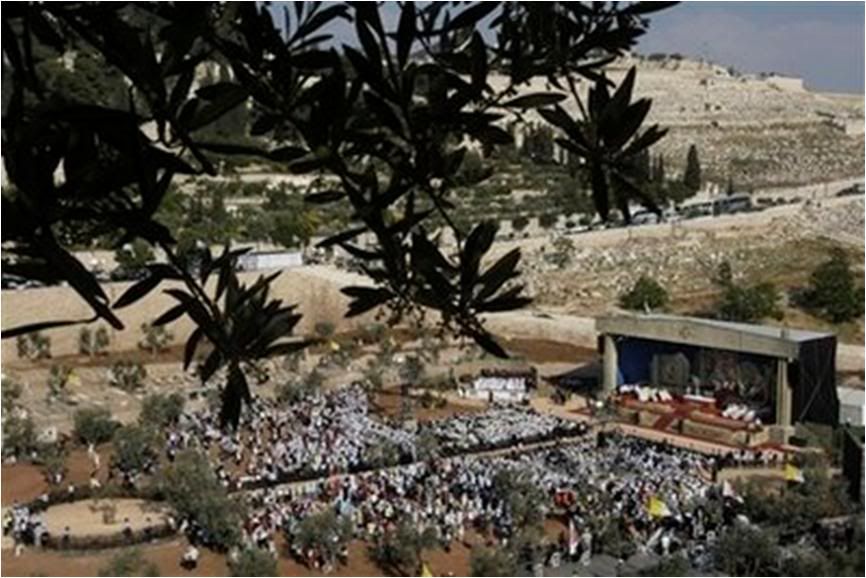 The Mass at the Valley of Josaphat just below the Moutn of Olives. Photo below shows the mass site inr elation to the Church of Gethsemane (top left and inset).
The Mass at the Valley of Josaphat just below the Moutn of Olives. Photo below shows the mass site inr elation to the Church of Gethsemane (top left and inset).
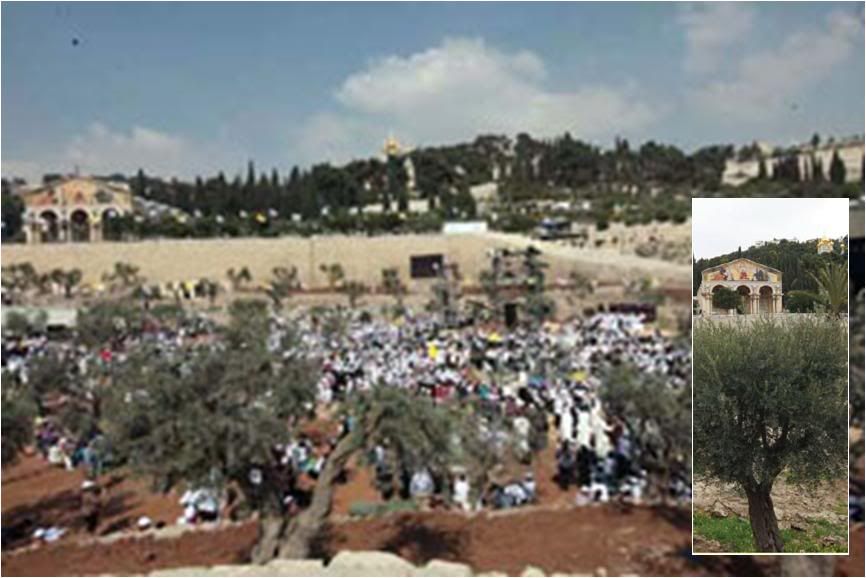
JERUSALEM, May 22 (AP) - Roman Catholic officials want an explanation from Israel for the poor turnout at Pope Benedict's open-air Mass in Jerusalem last week.
The Vatican's ambassador to the Holy Land says Church officials are conducting an "inquiry" into reports that people with tickets were turned away at the entrance.
About 5,000 worshippers were expected at the Mass. But no more than 3,000 people arrived.
Worshippers were required to have tickets to enter, and due to heavy Israeli security, they had to arrive hours ahead of time.
Monsignor Antonio Franco, the papal nuncio to the Holy Land, says it's premature to blame Israel for the logistical problems. But he says he will press the Israelis for answers.
An Israeli police spokesman says the event went smoothly from a security perspective, and says he doesn't know why people did not attend.
In fairness, news reports on the day of the Mass mentioned that many people chose not to come to the Mass because of the inconvenience in security arrangements that required attendees to be there hours before the event and because the strictest security measures were in place.
[Modificato da TERESA BENEDETTA 23/05/2009 22:30] |
| |
 23/05/2009 22:06 23/05/2009 22:06 |
|
| | | OFFLINE | | Post: 17.508
Post: 216 | Registrato il: 28/08/2005
Registrato il: 20/01/2009 | Administratore | Utente Junior | |
|
 Benedict XVI in the Holy Land:
Benedict XVI in the Holy Land:
A pilgrimage in the footsteps
of the Risen Christ
by Cardinal Leonardo Sandri
Prefect of the Congregation for Oriental Churches
Translated from
the 5/22/-5/23 issue of

The unforgettable pilgrimage in the land of our Lord, undertaken by Benedict XVI on May 8-15, was distinguished by his encounters with the local Church.
The Pope, drawing up an assessment of the trip at his first General Audience after his return, defined it as "a community of singular importance because it represents a living presence in the place where the Church had its origins".
Thus, he confirmed the eulogy he addressed to the Oriental Churches when he visited our Congregation on June 9, 2007, abd called them "living custodians of Christian origins".
The future of the universal Church depends even today on its link with the Church of its origins. I am sure I am interpreting fully the sentiments of the pastors and the faithful in that portion of the People of God who live in the Holy Land, a true pusillus grex [little flock] but of vital significance for the entire Church, in thanking the Pope, above all for the encouragement, comfort and hope that he has offered the Catholics, and for the prayers he shared at some holy sites with the different rites.
It is a heartfelt gratitude for having exhorted all Christians to remain as living stones in that land where everything speaks of the historic passage of the Redeemer on earth.
"Precariousness, isolation, uncertainty and poverty", the Pope said at the General Audience, are responsible for the seemingly unstoppable exodus of Christians from the region.
But we cannot resign ourselves to this and let such problems have the last word. The Pope is not giving in, and the Church follows him with great hope.
The entire itinerary in Jordan, Israel and the Palestinian Territories was summarized by the Pontiff as having been 'in the sign of the Resurrection of Christ".
Thus, the vicissitudes of the past, the wars aand destruction of the present, and even the conflicts among Christians, will not hinder the Church which is sustained by the Spirit of the Risen Lord.
The Cross having been glorified, its work will continue. Of that we are sure. According to St. Paul's teaching, Christ on the Cross brought down the wall of separation. Therefore, every obstacle to the recomposition of unity among human beings, as the Risen Lord desires, is inexorably destined to disappear.
The Pope's support for the Christian community in the Holy Land carries with it an impetus towards its mission of unity and peace. Every stage revealed the ecumenical and inter-religious dimension of the Pope's trip.
And the aspect that was clearly social and political emerged in the Pope's meetings with the political authorities of Jordan, Israel and the Palestinian Territories.
But even in this area, the Successor of Peter presented himself as the leader and father of the communities entrusted to his care by the Lord.
The whole Church was with him, concretely manifested in the local Christian community. In the name of the Church, it confirmed the will for dialog and collaboration with the two other great monotheistic religions who see in Jerusalem an irrepressible prophecy of peace.
Now it falls on the local community to try to realize this mission day by day. It will do so starting with the liturgical celebration of the Paschal mystery - source and summit of its life and its mission.
The educational, humanitarian and social works, often extraordinary, that are carried out and maintained with a thousand sacrifices by the Catholics of the Holy Land, flow from the community's irrenunciable Christian identity.
The possible and therefore obligatory dialog that the Pope has re-launched, will be realized in the daily witness and ordinary services of that local Church, in its persevering faithfulness to God and to men.
Some voices have pointed out that dialog should not be overstressed. And that is true. It is a means and not the goal. On the sacred mountain of Biblical convocation, the perfect communion of all with the one God will take place: that is the goal, and everything is oriented to it.
But while we are still within time, dialog, though arduous and uncertain, affirms that we are on the same path - it exalts a common vision, perhaps not fully elaborated, but one that is felt and desired. It nourishes an expectation which is shared.
The dialog that is now going on, even with its weaknesses, reveals for the good fortune of everyone a secret but common conviction: that we all belong to one family beloved by the only God, father of all.
In this sense, every encounter is always an appreciable milestone and never an illusion. But the meetings that have taken place does not mean that we stop there. Rather, they comfort us and render the next steps easier and faster.
I lived, alongside the Pope, days of great spiritual intensity.
Everywhere he was submerged in a welcome that was as sincere as it was affectionate, which called to mind the far greater numbers of all the men and women around the world who accompanied him with their fervent prayers in those days.
Without forgetting that, in fact, watching over Peter were the host of witnesses who are already with God: the patriarchs and the prophets, the apostles and the martyrs, the holy monks and hermits, Christian pilgrims and seekers of the Absolute, all preceded by the Mother of the Lord, and who have been led to the Promised Land down the centuries by the unutterable fascination of becoming a man of God.
Far more numerous than those who visibly surrounded him was the Church which accompanied him, which was evoked and truly convoked in every celebration of the holy mysteries.
The peaks of the pilgrimage therefore should be seen in the Eucharistic celebrations presided over by the Holy Father in Amman, Jerusalem, Bethlehem and Nazareth; in the prayer with consecrated persons at the Melkite Cathedral of Amman and in the Basilica of the Annunciation; in his prayers at Calvary and at the empty tomb of the Risen Lord.
In those places and in those 'holy' events, the Bishop of Rome confirmed that the trip "had as its primary objective a visit to the Catholic community of the Holy Land". To sustain that community means to guarantee a precious asset to the Holy Land, perhaps something indispensable to its course in the present and in the future.
To offer the members of that Church, particularly the young people who view tomorrow with concern, adequate housing conditions, education, work, as well as personal and familial freedom of movement, means defending the dignity of everyone not with words but in deeds.
And it is they, the local Catholics, who must now cultivate the good seed that the Pope has planted in that land which is both 'good and holy'.
The blessing of God will amplify this generous sowing, but the abundance of the harvest will depend on their faithfulness. Certainly, the international community should cement together this adventure for peace, which is always possible, even in Gaza, with belief in the solidarity among men and fighting every kind of unjust discrimination.
The Catholic communities should never tire of asking for the blessing of true religious freedom, contributing with all their strength to pursuing this goal which is a guarantee of the inviolable right of every human being.
The Lord will not leave them alone there, where for the first time, his holy name resounded. And Benedict XVI has assured them that the Church of Christ will always be at their side.
|
| |
 23/05/2009 23:03 23/05/2009 23:03 |
|
| | | OFFLINE | | Post: 17.509
Post: 217 | Registrato il: 28/08/2005
Registrato il: 20/01/2009 | Administratore | Utente Junior | |
|
 Pope approves Compendium of his Letter
Pope approves Compendium of his Letter
to the Catholics of China
by Fr. Bernardo Cervellera
Editor

Vatican City, May 22 (AsiaNews) – Two years on since the publication of his Letter to the Catholics of China, Benedict XVI has approved a “Compendium” of the document that will be available as of tomorrow on the Vatican website in Chinese and English.
Tomorrow is also the World Day of Prayer for the Church in China, called for by the Pope in the concluding part of his 2007 Letter.
According to a statement released by the Holy See press office, the Compendium “reproduces the basic elements” of the original Letter, but in the 'catechetical literary genre of questions and answers'.
The Compendium was forcefully called for by Cardinal Joseph Zen, former Archbishop of Hong Kong, and great defender of religious freedom in China.
It “faithfully reproduces, both in structure and language, the content of the original Letter, quoting extended passages from it. With the addition of some footnotes and two short Appendices, the “Compendium” is presented as an authoritative tool facilitating a deeper understanding of His Holiness’s thought on some particularly delicate points”.
One of those “delicate points” is the way in which to confront the Patriotic Association – the organism that controls the official church – whose aims are defined by the Pope as “irreconcilable with Catholic Doctrine”.
Many Catholics, both in China and abroad, believe that, in the aftermath of the Letter, a relationship of sorts with the PA is necessary as the “lesser of two evils” and have declared the era of the underground Church over, given its total refusal to collaborate with the PA.
Following the publication of the Letter, some underground bishops have sought to have themselves recognised by the government, refusing to become members of the PA. But the government has rejected their appeals and they remain illegal bishops and therefore punishable with prison.
The Pope’s Letter was not easily accessible in China: the PA banned its publication and websites that carried it were forced to remove it from their pages. Some priests who had distributed it were arrested. The full text of the Letter available on the Holy See’s new website in Chinese cannot be accessed from China.
Today’s statement however confirms that Benedict XVI’s document met with a “highly favourable reception given to it by the Chinese Catholics who had access to it.”.
One of the fruits of this Letter is greater collaboration between official and underground Catholics. Many underground bishops have begun to collaborate in pastoral initiatives with official bishops, but because of this, they have met with persecution.
Over the past few months bishops recognised by the government have been called to submit themselves to political sessions on the value that the Chinese Communist Party places on religious policies, that have lasted for weeks and even months.
Underground bishops, for the most part, remain under constant house arrest. Moreover, three underground bishops have completely disappeared in police custody. They are: Msgr. James Su Zhimin (diocese of Baoding, Hebei), 75, arrested and whereabouts unknown since 1996; Msgr. Cosma Shi Enxiang (diocese of Yixian, Hebei), 86, arrested and whereabouts unknown since April 13 2001; Msgr. Julius Jia Zhiguo, arrested once again on March 30th last as he prepared to work together with the official bishop of Shijiazhuang, Msgr. Jang Taoran.
[Modificato da TERESA BENEDETTA 23/05/2009 23:04] |
| |
 24/05/2009 00:48 24/05/2009 00:48 |
|
| | | OFFLINE | | Post: 17.510
Post: 218 | Registrato il: 28/08/2005
Registrato il: 20/01/2009 | Administratore | Utente Junior | |
|

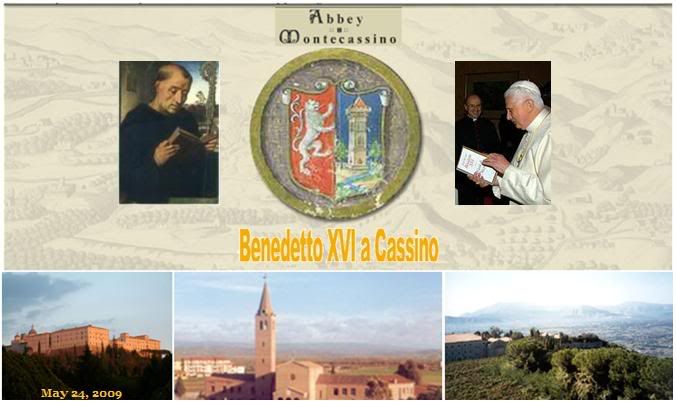 Towards a fully-aware faith:
Towards a fully-aware faith:
Benedict XVI returns to Montecassino
by Carlo Di Cicco
Translated from
the 5/24/09 issue of

The last time Joseph Ratzinger was in Montecassino was for five days in February 2000.
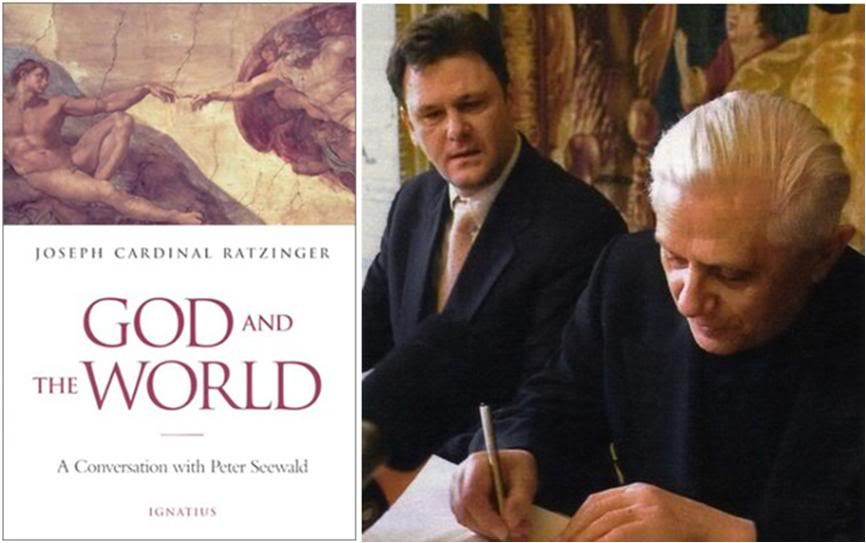
It was an occasion for the future Pope to mature some of his thoughts - as he later wrote, recalling the long interview he gave German writer Peter Seewald there, which then became the book God and the World.
It is about being Christian in the new millennium - 'a small attempt to introduce the faith to the man of today'.
And Benedict XVI's return to Montecassino today is part of that design which remains the one true secret for reading his pontificate in its true light.
He is returning to one of the oldest sources of Benedictine spirituality that is at the root of his Christian formation and explains his insistence on exhorting Christians to a faith that is fully aware, if they wish to reawaken the cultural capacity of European society that is in a phase of great change as a result of so many unforeseen factors.
As in the time of St. Benedict - father of Western monasticism - when the society inherited from the Roman Empire was put to the test by the new peoples that had come from the outside world, and not always in a friendly way, so today, Europe must deal with the tens of thousands of immigrants that have arrived on the continent, driven out of their native countries by necessity.
The recomposition of the human fabric, which must result in time from mass migrations, finds in the Benedictine example a paradigm which can still be effective.
From their infancy, children in the lands influenced by St. Benedict were strongly imprinted with the figure of Totila, King of the Goths, who laid down his sword at the feet of the patriarch Benedict.
What reason could there be - we may well ask - for a king, at his moment of triumph, to kneel before a powerless man in a land that had been so trampled by opposing combatants?
St. Benedict was credited for his wise perspective of reconstructing the social and religious fabric that had been torn apart in the successive invasions.
And the reconstruction was according to his own Christian life spent entirely for others - in the light of his famous exhortation "Do not place anything ahead of the love of Christ" which he imposed as rule of life for all his new monks.
Benedict XVI is closely linked to the Benedictine style and the Christian vision of the sainted founder of Montecassino.
He chose to bear his name, he committed himself right away towards mutual understanding among peoples and religions, he has called the Church and the faithful to be sincerely converted to a lived faith in which nothing comes ahead of God.
And the simple motivation is love. To convert for love to a God who loves and who must be perceived as a God of love even in the 21st century.
The Pope who advocates harmony between faith and reason, prayer and work - in order for man to be able to carry on the search for the Absolute even outside religious precincts - hopes to be able to convert Christians first of all to the primacy of God's love.
In fact, he points out that social activism by believers - when it is not spiritually animated - remains sterile.
The power of Christian witness - which at one time was left to monasticism at the time of its flowering - is diminished by the shrunken dimensions of consecrated life today.
In line with the Church of Vatican-II, the Pope asks of every Christian to take on the responsibility of the Gospel in his daily life. The meeting today (Sunday) with the faithful of Montecassino and all Cassinate is inspired by this vision.
Because he is impelled by the spirit of colloquium with everyone in order to consolidate the peace, Benedict XVI can be counted among those unarmed prophets in a world that is more fraternal and solid, a goal towards which so many persons have dedicated their lives.
 The Abbot of Montecassino recalls
The Abbot of Montecassino recalls
his first meeting with Cardinal Ratzinger
Interview with Abbot Pietro Vittorelli
by VITTORIO BUONGIORNO
Translated from

May 23, 2009
The Holy Father is coming here a few days after his trip to the Holy Land.
He arrives at a special moment in his Pontificate, after a most important trip during which he preached the importance of peace, diplomacy, dialog.
I am happy to think that at Montecassino he may be able to find a bit of restoration as well as that festive welcome for someone who is coming home.
What do you remember of the last visit of then Cardinal Ratzinger to Montecassino?
I was most impressed with his monastic attitude, his full insertion into the rhythm adn life at the monastery, his ability to concentrate for hours on a task that is not always easy.
He devoted a week here to the interview that would become the book God and the world, and I had the assignment and the honor to be of assistance to him. He was enraptured by the atmosphere here.
Then there was the kindliness of his nature, almost timid, respectful of everyone, from the abbot down to the porters and the sacristans.
What will you ask of the Pope?
On occasions like this, one thinks more of what one should give him. He already carries a lot on his shoulders.
The central event of the visit will be the inauguration of the House of Charity.
That, too, is a dream for me. When we were putting together our efforts for solidarity in the parish, I never imagined that the fruit of those efforts would be blessed by the Pope himself. If one thinks back now, one sees it as a sign of God's blessing.
But this is only the beginning. We have to sustain it so that it has a future, and can provide a future for those who will find hospitality there.
How was the idea born?
Shortly after I was elected abbot, the local Caritas had to lodge an African mother with her baby in a minibus because the hotels did not want to accept her, and there was no other solution.
I was indignant - it was Christmas - and so I thought of the old regional hospital that was abandoned, and I spoke to the president of the region so that we could renovate part of the complex into a hospitality center for foreigners who are in need, and also people leaving jail who do not have a place to go to.
The question of immigrants has been much discussed in our country lately.
It is an emergency about which the Church is called to give a credible response, even in the face of some rather xenophobic trends, of positions that are not always cordial towards those who are in difficult circumstances and who are forced to leave their own countries.
It is a delicate question, as every time one holds out a hand to someone who is needy, there is the risk that he will refuse or take offense, but as a Christian, as a man and citizen, we cannot fail to show the world how far we have come along in a civilization marked by the evangelical message.
We must show the fruits of cultural growth, which does not mean closing up but welcoming, with an ability to be patient even with those who do not yet know how to follow the rules of human coexistence.
What will the Casa della Carita mean for Cassino?
I would like all our diocesan entities to collaborate in a single project. And charity is one of the virtues that each Christian is called upon to practise.
You have called particularly on young people to take part in this project.
In order to give substance to their youth, so they don'taste their free time simply on play stations and watching TV, which certainly are normal activities for their age, but cannot be the most significant part of their life. I have asked them to come and see what it is to live and work with the marginalized, the poor, the strangers.
And how have they responded?
There has been some response - not as great as I would have wanted. But it is just as important that some do commit themselves and set an example. But my dream is that this house of charity will not only help the poor and disadvantaged but provide an opportunity for growth to our young people and to our educators.
What message will come from Montecassino tomorrow, where all the Benedictine abbots and abbesses from around the world will be gathered together with the Pope?
That there can be unity out of diversity. All the abbots and abbesses do not necessarily live the Rule [of St. Benedict] in the same way, but that is the strength of the Rule - that it is adaptable to any population in any part of the world, because it is firm on one point: that the truth comes from Jesus, for whoever lives the Rule here or in Africa, in Colombia or Argentina.
It makes possible peaceful coexistence and unity around universal values that are acceptable to believers as well as non0believers - values like respect for life, civil coexistence, the right to education and to health. Any race and people can unite around these values.
Will anything change in the Abbey after this visit?
That's difficult to say for an abbey that has 1500 years of history and which has seen a whole series of Popes come and go. Of course, the visit of a Pope who took the name of St. Benedict will make us more committed to express our monastic life according to the directions for the Church coming from the Pope. We will listen to what he will tell us and we shall be carry it out humbly.
And on Monday?
We will return to the centuries-long quiet of the Abbey and resume our monastic life of silence, prayer, work, and hospitality.
From the Sunday OR, here's another interview with Abbot Vittorelli:
The Pope at the heart
of Christian Europe
An inrerview
by NICOLA GORI
Translated from
the 5/24/09 issue of

The expectation, the hope, the joy at the arrival of Benedict XVI on a visit to the abbey and dicoese of Montecassino this Sunday, are echoed in the interview given by Abbot Pietro Vittorelli to this newspaper.
Benedict XVI comes to Montecassino bearing his strong links with St. Benedict. How have these links emerged so far in his Petrine ministry?
Benedict XVI has underscored many times, from the start of his Pontificate, a rootedness in Benedictine spirituality, re-proposing it in his discourses and catecheses, which show a remarkable synthes of 'nihil amore Christi praeponere' [Do not place anything ahead of Christe) that St. Benedict has in the fourth chapter of his Rule "On the instruments of good works) (4,21), and which the Holy Father has cited many times. almost as a leitmotiv of his theological narratives.
When on the evening of April 19, 2005, from the Loggia of Benedictions, Cardinal Jorge Arturo Medina Estevez announced to the world that Cardinal Ratzinger had been elected Pope and that he had chosen to be called Benedict, besides the uncontainable joy of the entire monastic world - which in Montecassino was all caught up in the sound of pealing bells and peak usage of the telephone and e-mail, - some monks did not miss the immediate reference to the Rule of St. Benedict in the new Pope's first words declaring himself to be 'a humble worker in the vineyard of the Lord'.
Although the Gospel reference was clear, the expression of humility so typical of St. Benedict was equally unmistakable, along with the expression in the Prolog to his Rule 'Et quaerens Dominus, in moltitudine populi cui haec clamat, operarium suum' (And the Lord, seeking his laborer in the multitude to whom He cries out)...
In the tireless Petrine service of Benedict XVI, there has never been any lack of reference to the importance of Europe's Christian roots and the service rendered to the Churcc in this regard by the monks and nuns of St. Benedict. But the Pope does not just have an 'archeological' regard for Benedictine monasticism: he grasps it in all its vitality and the prospects it has for the future.
When he received the World Congress of Benedictine abbots in September 2008, he said: "To construct a new Europe, one must begin with the new generations", before widening the perspective to the entire human family to underscore that "in many parts of the world, especially in Asia and Africa, there is a great need for vital spaces that enable an encounter with the Lord, in which, through prayer and meditation, man can recover serenity and peace within himself as well as with others".
But the text which, to my mind, will remain the 'Benedictine manifesto' of his Pontificate was the magnificent lecture he delivered at the College des Bernardins in Paris, in his encounter the world of French culture.
He introduced it by saying "I wish to speak to you this evening of the origins of Western theology and the roots of European culture", and with that theological mastery which is typical of him, and with a monk's heart, he wove the most beautiful song about 'quarere Deum', searching for God.
The Pope's references to St. Benedict necessarily validate his reflections on Europe. Do you think Benedict XVI's visit will have a meaning for the entire continent in its search for its Christian roots?
The visit of a Pope named Benedict to the cradle of Western monasticism, in the place which has reflected the eyes of St. Beenedict, from which came the impulse for a new evangelization of the European continent, cannot fail to have an echo in contemporary Europe.
The Pope willl reaffirm the importance for contemporary man to re-appropriate a kind of workday mentality, the normality of the Benedictine day-to-day routinr of 'ora et labora et lege' (pray and work and read) which can continually shape man.
"In your monasteries, you primarily renew and deepen daily your encounter with the person of Christ, whom you always have with you as guest, friend and companion. That is why your convents are places where men and women, even in our time, go to expressly to look for God, to learn to recognize the signs of the presence of Christ, of his love, of his mercy". That is what he said at the last audience that he gave to Benedictine abbots who were meeting in an international congress.
The diocese of Montecassino is historically dependent on the abbots of the Abbey. Does this bring any difficulty in carrying out the diocesan pastoral work that this requires?
The diocese of Montecassion is Montecassino, and Montecassino is its diocese. The indissolunle link which has united our parishes and our population at the monastery and its abbot have 15 centuries of history, which began with the arrival of St. Benedict himself in the sixth century.
In the following centuries, it underwent modifications the demands of changing times and which the wisdom of my predecessors aa abbots were able to harmonize.
Today our diocese, after a long path by Synod, has executed all the recommendations of Vatican-II.
Difficulties arose when for a long time, we suffered indecision over the future of the abbatial territory itself. That period created such uneasiness among the clergy about their future, and above all, among the faithful who had become so embedded in the Benedictine matrix.
Now that the Holy See has confirmed a new stability with the nomination of a new abbot and diocesan bishop, the life of this small but significant diocesan Church has resumed its centuries-long path, conserving the prayerful force of a monastic community, amd among them, the passionate testimonies of so many priests who were raised in the school of St. Benedict.
The pastoral plan which we unveiled last year for the diocesan Church provides for a five-year period dedicated to reflecting on the Word of God.
The Abbey of Montecassino is undoubtedly a reference point for Western monasticism. What does it represent today for teh Order and for contemplative life?
Montecassino remains the mother house for all Benedictines. From the world, there is a constant passage of monks asnd nuns paying homage at the tomb of St. Benedict, and certainly, Montecassino represents for everyone the heart of St. Benedict's experience.
The Holy Father himself, when he presented the figure of St. Benedict in the general audience of April 9, 2008, said: "Monastic life in its hidenness has a reason for being, but a monastery also has a public purpose in the life of the Church and of society - it should give visibility to the faith as a force of life".
Thus he justified authoritatively the passage of St. Benedict from Subiaco - which remains the other great Benedictine center - to Montecassino, which, from the experince of St. Benedict, is precisely the visibility of faith as a force of life.
Does Benedictine spirituality have any influence on the religious life of the diocesan faithful?
Yes, they are totally immersed in Benedictine spirituality. Many of our outstanding priests were educated by the monks when the seminary was in the monastery. The attention to liturgy, the love for choral singing, the ringing of the bells at Angelus three times a day in all our parishes, the appetite for the Word of God, the nocturnal pilgrimage to the abbey for Pntecost vigil, are just examples.
Imagine that a small diocese like ours has 28 parish choirs who we listen to every year in a much-awaited general concert, with a continuous rediscovery of Gregorian chant and traditional polyphony ehich had admirable promoters from our monks in the 20th century: Dom Mariano Taccarino and Dom Luigi De Berio were master teachers for many.
Every year for the Feast of St. benedict, on March 22, we celebrate a true and proper Day for Europe, and to rediscover Benedictine roots specifically, the historical pageant Terra Sancti Benedicti was instituted 15 years ago. Every year, this involves some 500 persons, mostly young people, who evoke the times of the Abbot Bernardo Ayglerio between the 13th and 14th centuries, with costumes and episodes based on historical research.
Then we have the St. Benedict Catholic School in the city which is run by our monks along with the Sisters of Charity of St. Giovanna Antida Thouret, which has 500 pupils from kindergarten to classical lyceum (high school).
Do St. Benedict and St. Scholastica (his twin sister) attract pilgrims from other faiths?
We often have Buddhist monks as guests who want to be acquainted with our form of life. We have had visits from Muslims, including ranking personages like King Abdullah of Jordan, whose grandfather had fought here in Montecassino during World War II; also, Mr. Khatamee of Iran when he was president. And so many Jewish guests as well, especially from the Jewish community in Rome.
Montecassino is also a place which recalls the horrors of war. What is the commitment of your monks and the diocese to the cause uf peace?
Several decades ago, the death and destruction that befell the abbey and its territory devastated thousands of human lives here around us. This land has resonated with the cries of sorrow and the weeping of families and individuals. All this has led both abbey and diocese to continuously work in order to build the peace.
This commitment is solemnly renewed every year on the anniversary of the bombardments over Montecassino and the city, to which surviving veteans come in order to reaffirm their commitment to peace.
[Modificato da TERESA BENEDETTA 21/03/2013 15:44] |
| |
 24/05/2009 12:52 24/05/2009 12:52 |
|
| | | OFFLINE | | Post: 17.511
Post: 219 | Registrato il: 28/08/2005
Registrato il: 20/01/2009 | Administratore | Utente Junior | |
|

May 24
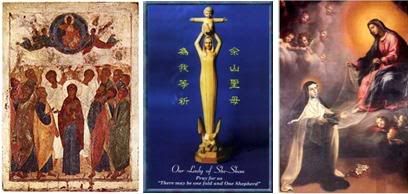 ASCENSION SUNDAY
ASCENSION SUNDAY
FEAST OF MARY, HELP OF CHRISTIANS (Virgin of She-Shan)
[World Day of Prayer for China]
ST. MARIA MAGDALENA DI PAZZI(Italy, 1556-1607)
Carmelite nun and mystic
'The ecstatic saint'
OR today.
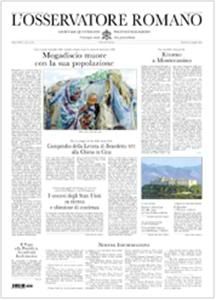
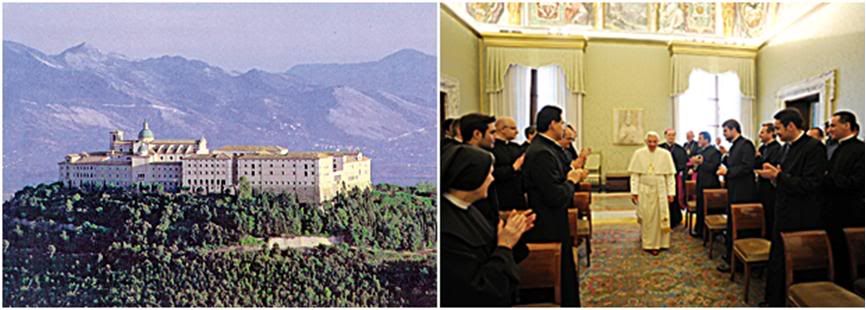 The Holy Father's pastoral visit to Montecassino is the occasion for a mini-special which leads off with a Page 1 essay on Benedict XVI's 'Return to Montecassino' (translated in the post above), and in the inside pages, an interview with the Abbot of Montecassino (also translated above), a review of papal visits to Montecassino, and an essay on the roots of Benedict XVI's Pontificate in the St. Benedict, patron Saint of Europe [to be translated]. Other papal stories on Page 1 are about the publication of the Compendium of the Pope's letter to the Chinese Catholics two years after it was issued (May 27) and the Pope's address to the Pontifical Ecclesiastical Academy which trains future Vatican diplomats (right photo above). The Page 1 headline is about death and destruction in Mogadishu brought on by the ongoing civil war in Somalia, and there is a story - surprise, surprise! - on what United States bishops consider the absolute limits of any dialog on ethical issues with the White House and Congress.
THE POPE'S DAY
The Holy Father's pastoral visit to Montecassino is the occasion for a mini-special which leads off with a Page 1 essay on Benedict XVI's 'Return to Montecassino' (translated in the post above), and in the inside pages, an interview with the Abbot of Montecassino (also translated above), a review of papal visits to Montecassino, and an essay on the roots of Benedict XVI's Pontificate in the St. Benedict, patron Saint of Europe [to be translated]. Other papal stories on Page 1 are about the publication of the Compendium of the Pope's letter to the Chinese Catholics two years after it was issued (May 27) and the Pope's address to the Pontifical Ecclesiastical Academy which trains future Vatican diplomats (right photo above). The Page 1 headline is about death and destruction in Mogadishu brought on by the ongoing civil war in Somalia, and there is a story - surprise, surprise! - on what United States bishops consider the absolute limits of any dialog on ethical issues with the White House and Congress.
THE POPE'S DAY
 PASTORAL VISIT OF HIS HOLINESS BENEDICT XVI
PASTORAL VISIT OF HIS HOLINESS BENEDICT XVI
TO CASSINO AND MONTECASSINO
Sunday, May 24, 2009
PROGRAM
09.00 Departure by helicopter from the Vatican
09.30 Arrival at the Salveti sports field in Cassino
10.15 EUCHARISTIC CONCELEBRATION
Piazza Miranda, Cassino
Homily by the Holy Father
12.00 Regina Caeli prayer
Words by the Holy Father
12.30 Travel by car to the Abbey of Montecassino
Brief visit to the Casa della Carità of Cassino
13.30 Lunch at the Abbey
16.30 Grreting to the monastic community of the Abbey
and to the organizers of the visit
17.00 CELEBRATION OF VESPERS
with Benedictine abbots and
the community of Benedictine monks and nuns
Basilica of the Abbey
Homily by the Holy Father
18.00 Private visit to the Polish Military Cemetery in Montecassino
18.30 Departure by helicopter
19.00 Arrival at the Vatican
Satellite view of the Abbey.

[Modificato da TERESA BENEDETTA 24/05/2009 22:29] |
| |
 24/05/2009 13:23 24/05/2009 13:23 |
|
| | | OFFLINE | | Post: 17.512
Post: 219 | Registrato il: 28/08/2005
Registrato il: 20/01/2009 | Administratore | Utente Junior | |
|
BENEDICT XVI IN CASSINO & MONTECASSINO

Upon his arrival by helicopter at the Salveti sport field in Cassino this mortning, Pope Benedict XVI was welcomed by politicla, civiliana nd ecclesiastical authorities.
He then proceeded by Popemobile to Piazza Miranda, the main square of Cassino, which starting today, by a decision of the Communal Council, will be called Piazza Benedetto XVI.

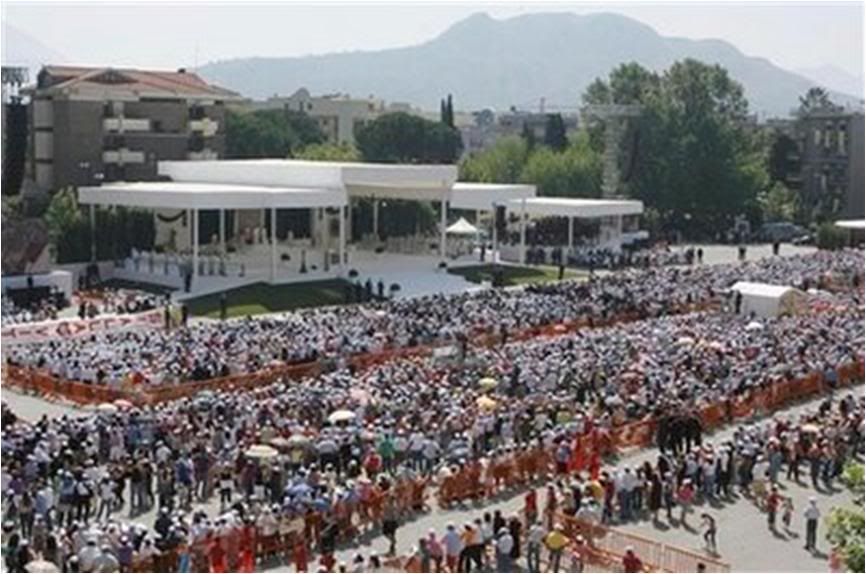
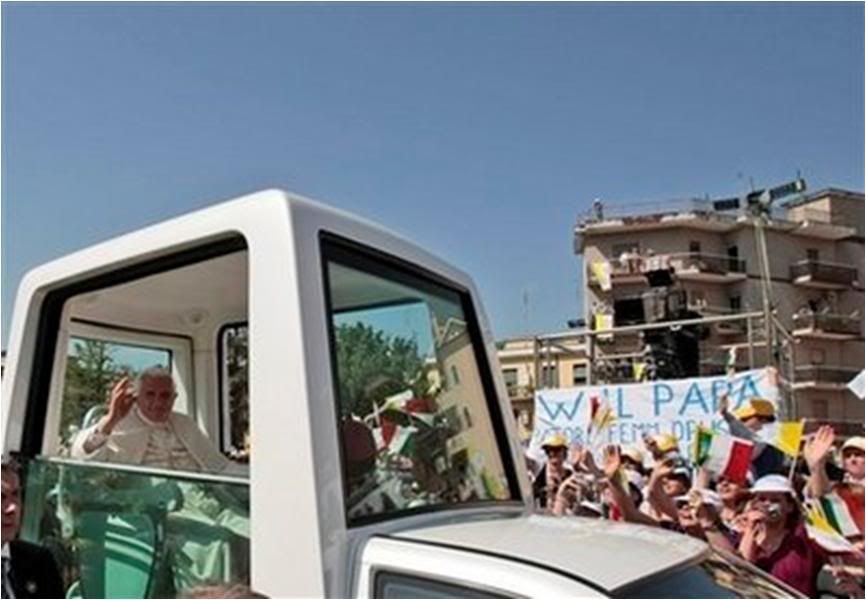
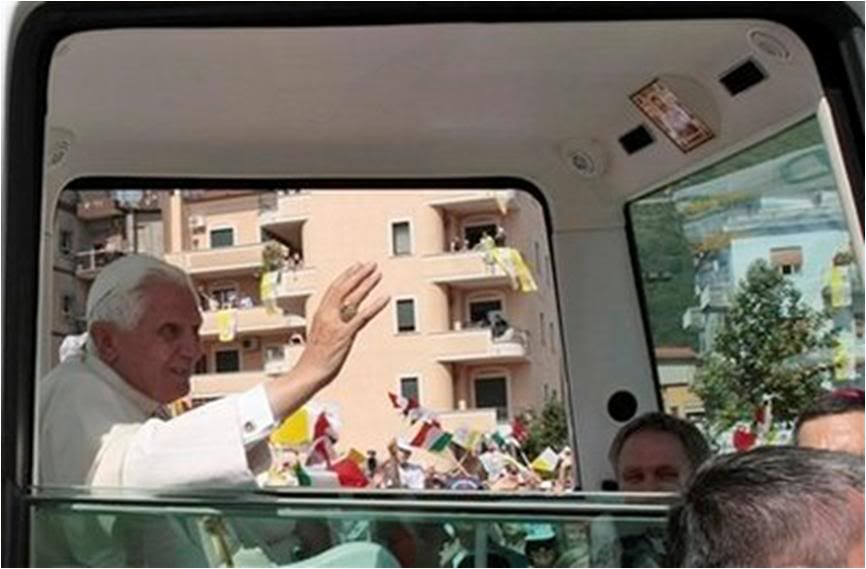
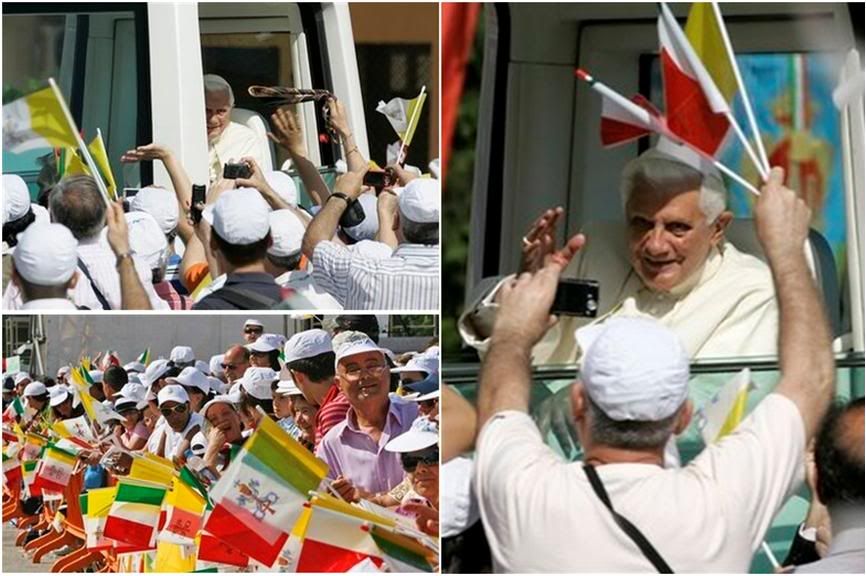
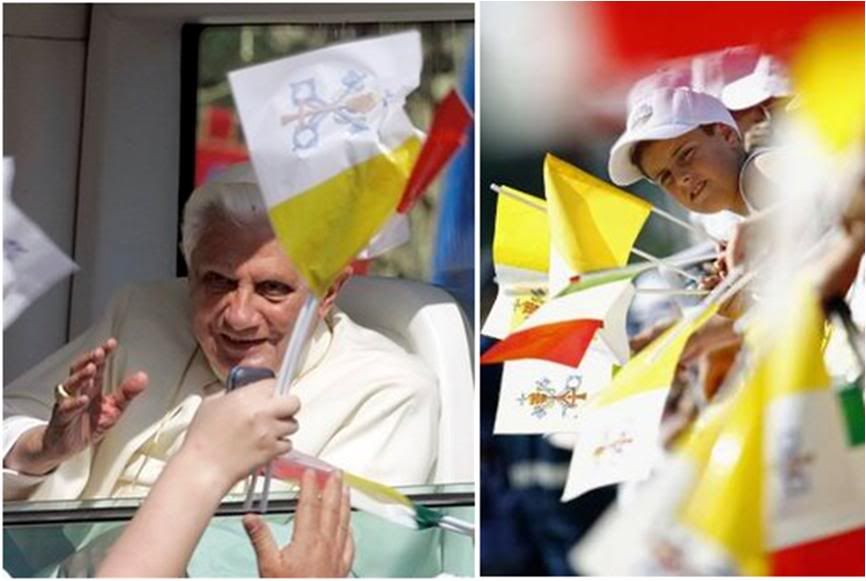
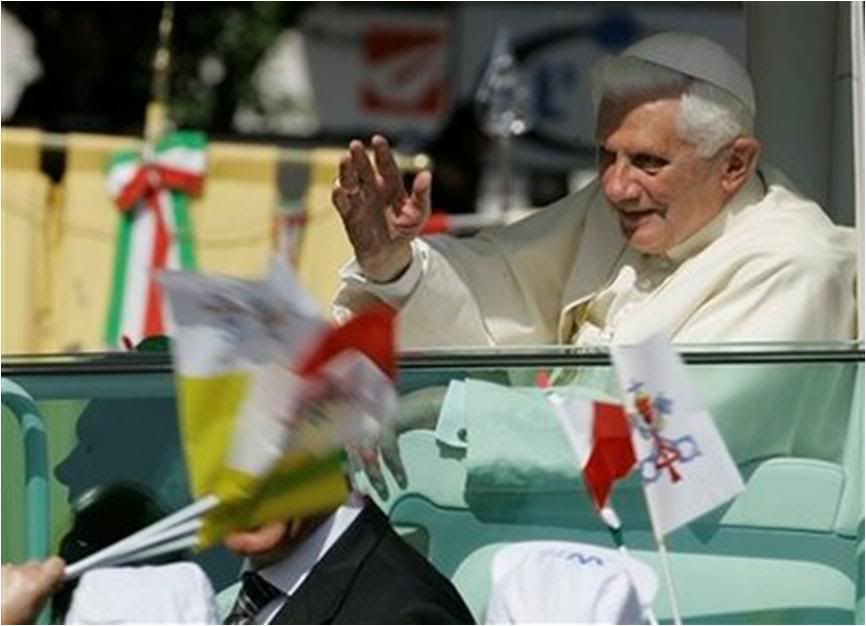
The PoPE received a formal welcome from the Mayor of Cassino, Dr. Bruno Scittarelli, who offered him in the name of the citizens, a Roman-style Crucifix from 1633.
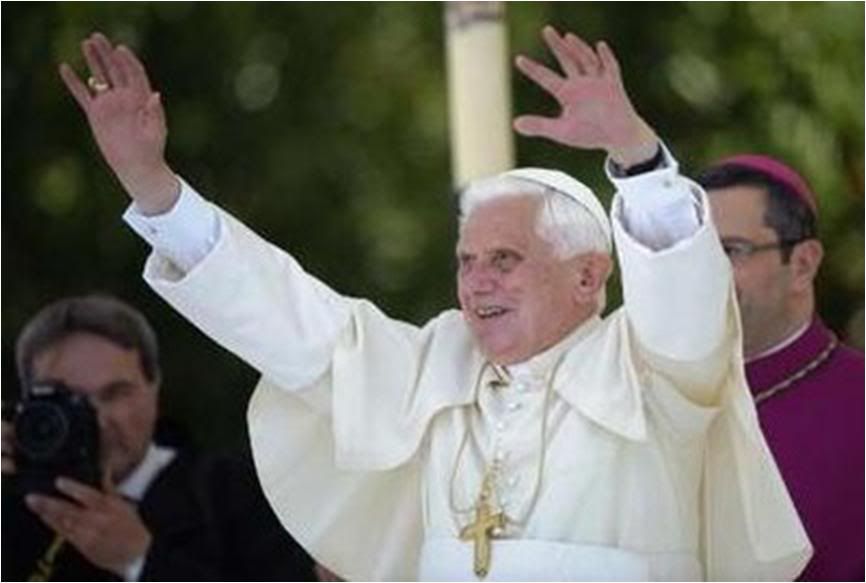
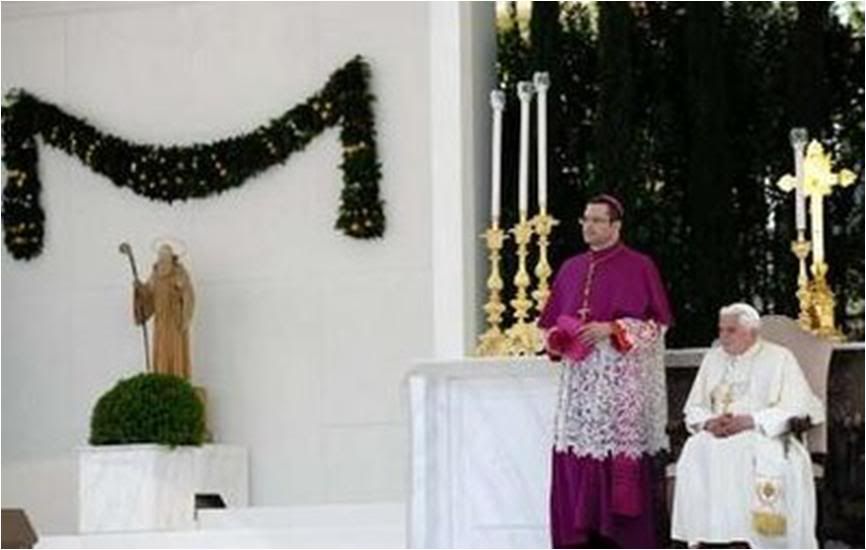
The Holy Father said a short prayer at the image of the Madonna that was set up at the altar, before walking to a nearby sacristy to vest for the Mass.
 THE MASS
THE MASS
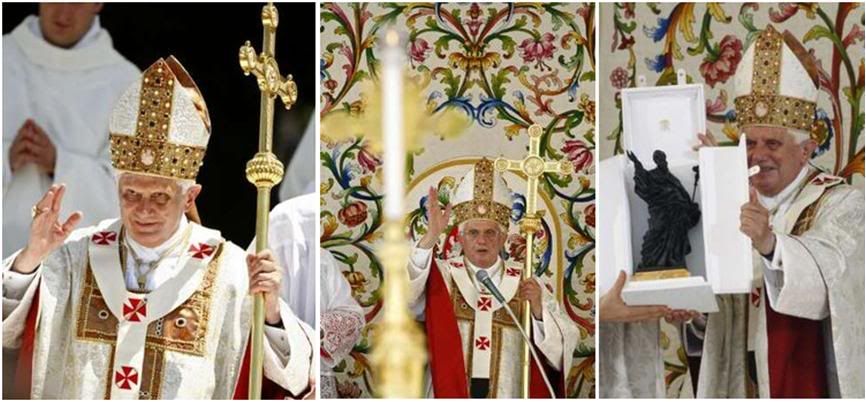 NB: The Mass at Piazza Miranda today - correction, at Piazza Benedetto XVI - was unusually special for the music, provided by a symphony orchestra and Montecassino diocese's famed choral voices that Abbot Vittorelli touted in one of the interviews posted earlier. The choice of music numbers was outstanding, and the sounds were glorious.
Benedict prays for peace
NB: The Mass at Piazza Miranda today - correction, at Piazza Benedetto XVI - was unusually special for the music, provided by a symphony orchestra and Montecassino diocese's famed choral voices that Abbot Vittorelli touted in one of the interviews posted earlier. The choice of music numbers was outstanding, and the sounds were glorious.
Benedict prays for peace
at site of WWII battle

CASSINO, Italy, May 24 (AP) — Pope Benedict XVI prayed Sunday for an end to all wars, making a pilgrimage to the site of a decisive World War II battle and decrying the destruction and lives lost there.
The German-born Benedict visited the Benedictine monastery at Monte Cassino, which was leveled during a 1944 Allied bombardment and was the site of a bloody ground battle between German and Allied forces.
Benedict, who, growing up in Germany was forced to join the Hitler Youth, cited the 65th anniversary of Monte Cassino's destruction before thousands gathered for Mass in Cassino, at the foot of a rocky hill on which the monastery sits.
"In this place, where so many lost their lives in the battles that were fought during the Second World War, we pray especially for the souls of the fallen, commending them to God's infinite mercy, and we pray for an end to the wars that continue to afflict our world," Benedict said in English at the end of Mass.
He added he was visiting the nearby Polish military cemetery later Sunday to pay homage to "all the military forces from diverse nations who gave valiant witness and lost their lives here."
The cemetery contains the remains of Polish troops who fought alongside the Allies and died trying to take control of the Monte Cassino abbey and surrounding positions from German troops. The battle for the battle was decisive for the Allied advance on Rome, 80 miles to the north.
Noting that all Benedictine monasteries carry the word "PAX" — peace — at their entrances, Benedict urged all Christians be witnesses to peace, saying it was a "challenging mission to be fulfilled everywhere."
Benedict was also making a personal pilgrimage to the Monte Cassino monastery, which has long been dear to him. It was founded in 529 by St. Benedict of Nursia, known as the father of Western monasticism and a patron saint of Europe.
The Pope has spoken frequently about his strong affinity for St. Benedict, a hermit and monk whose writings became the basis for the Benedictine order.
In his first general audience as Pope, in April 2005, Benedict said he had chosen to call himself Pope Benedict XVI to pay homage to St. Benedict, who he said was a "fundamental point of reference for European unity and a strong reminder of the undeniable Christian roots of her culture and civilization."
During his homily Sunday, the Pope cited the saint's commitment to both prayer and work, and said he was particularly concerned about the plight of workers in Cassino, home to a Fiat plant at risk amid the economic downturn.
"The wound of unemployment, which afflicts this land, compels those responsible for public life — businessmen and others who are able — to find valid solutions to the labor crisis, creating new jobs so families can be protected," Benedict said.
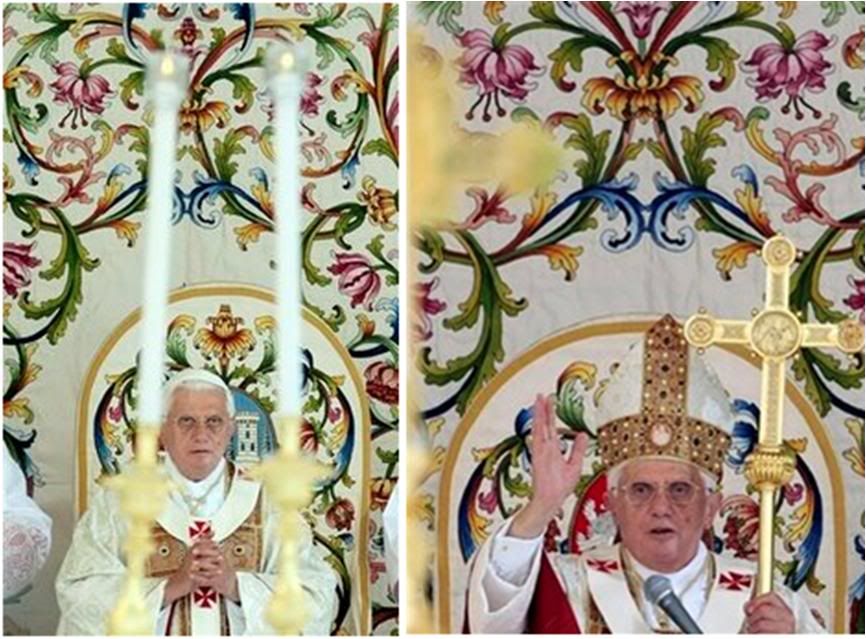
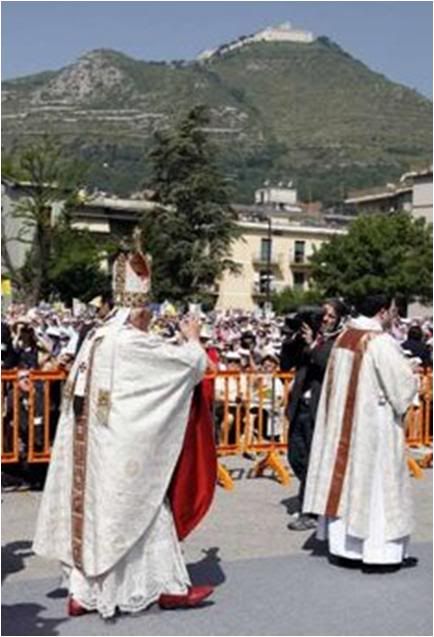 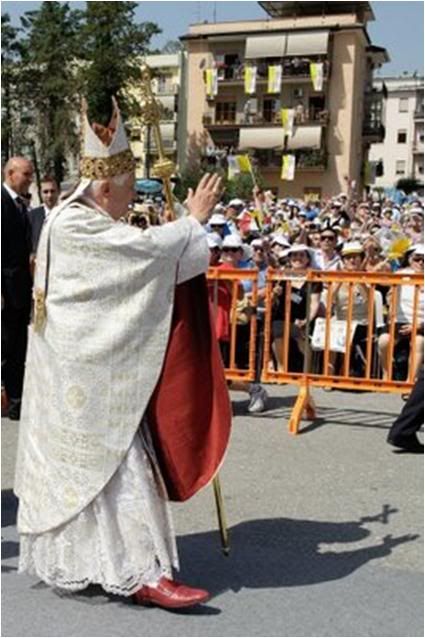
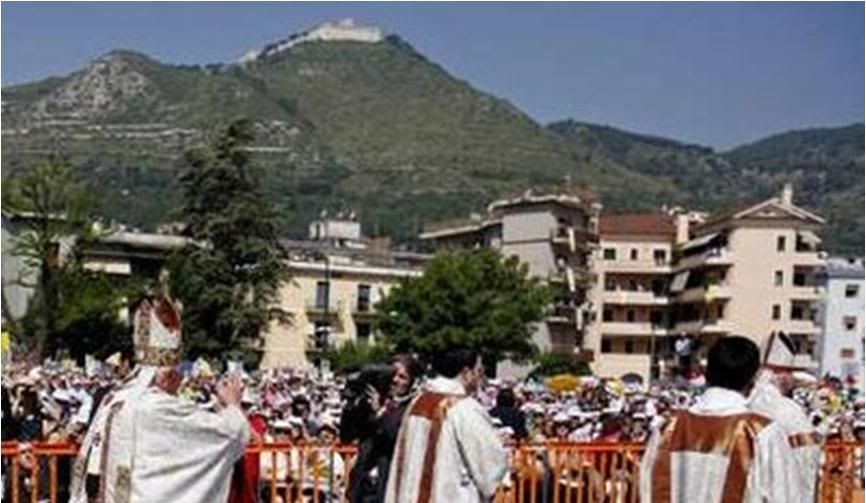 Pope prays For peace
Pope prays For peace
at site of WW2's largest
and bloodiest land battle

CASSINO, Italy, May 24 (Reuters) - Pope Benedict, visiting the scene of one of the bloodiest battles of World War Two, on Sunday prayed for an end to all violent conflict.
The Pope celebrated Mass for thousands of people at the foot of the Benedictine Abbey at Montecassino, which was destroyed in 1944 by Allied bombs and later rebuilt.
"In this place, where so many lost their lives in the battles that were fought during the Second World War, we pray especially for the souls of the fallen, commending them to God's infinite mercy, and we pray for an end to the wars that continue to afflict our world," he said at the end of the Mass.
The abbey was founded by St Benedict, whose name the former Cardinal Joseph Ratzinger took when he was elected Pope in 2005.
The battle of Montecassino, also known as the Battle for Rome, was one of the most complex and bloody of World War Two.
It lasted for nearly four months in early 1944 as Allied forces tried to penetrate Germany's Gustav Line to take Rome, resulting in 300,000 casualties on both sides.
Tens of thousands of soldiers were killed before the Allies broke through and captured the Italian capital as the Germans retreated north.
In his sermon, the Pope said the military cemeteries that dot the area were "silent witnesses" to suffering.
The battle saw the much-criticised destruction of the massive hilltop abbey by Allied bombing on Feb. 15, 1944.
The Allies had wrongly believed the Germans were using the site, founded by St Benedict in about 529, as a lookout.
The monastery had been standing for some 700 years. It took more than a decade to rebuild it after the war [completely at the expense of the italian government}.
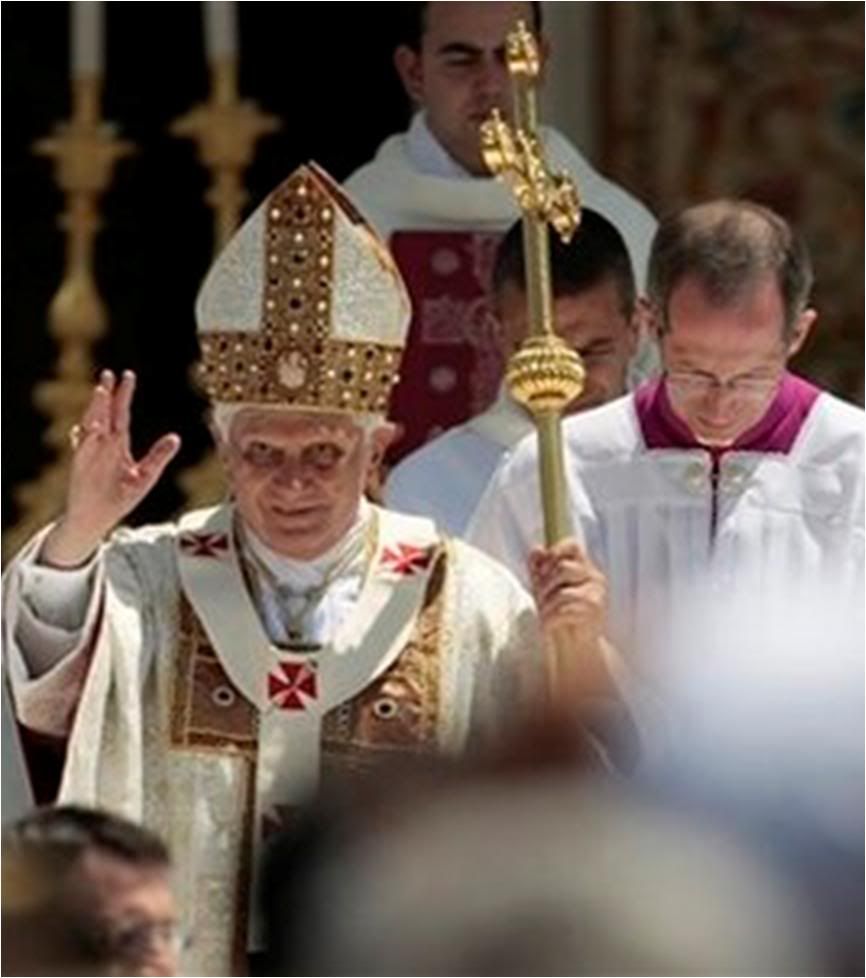
[Modificato da TERESA BENEDETTA 25/05/2009 18:10] |
| |
 24/05/2009 14:29 24/05/2009 14:29 |
|
| | | OFFLINE | | Post: 17.513
Post: 221 | Registrato il: 28/08/2005
Registrato il: 20/01/2009 | Administratore | Utente Junior | |
|
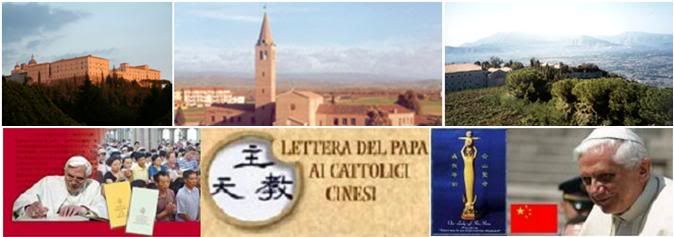 'From the land of St Benedict
'From the land of St Benedict
my thoughts go to the people of China
and its Catholics', says Pope

CASSINO, May 24 (AsiaNews) – Before reciting the Regina Caeli today Benedict XVI’s “thoughts” went to the people of China and his “affection” to the Catholics of China.
This is how the pontiff marked the World Day of Prayer for the Church in China, launched by him with the 2007 Letter to China’s Catholics, to take place each year on May 24th, the Feast of Our Lady Help of Christians, which is celebrated in a special way in the Marian Sanctuary of Sheshan in the foothills of Shanghai.
“Today May 24th – he said – the liturgical memory of the Blessed Virgin Help of Christians - who is venerated with great devotion in the Sanctuary of Sheshan, Shanghai - the World Day of Prayer for the Church in China is celebrated. My thoughts go to all the people of China,
"In particular I greet with great affection the Catholics in China, and I urge them on this day to renew their communion of faith in Christ and fidelity to the Successor of Saint Peter. May our common prayer obtain a spreading of the gifts of the Holy Spirit, so that unity between all Christians, the Catholicity and universality of the Church be ever deeper and more visible”.
Today’s Regina Caeli was proclaimed from Cassino (intoned and sung by the Pope), beneath the Benedictine Abbey of Montescassino, where the Pope is making a pastoral visit and where he celebrated Mass marking the feast of Our Lord’s Ascension.
During his homily the Pope underlined the contribution of Benedictine monasticism to the dignity of prayer, in the lectio divina, and to work.
"Saint Benedict was a great witness to peace", he said, "because he gathered it into his existence and saw it fruitfully multiply through works of authentic spiritual and cultural renewal. This is why, on the entrance to the Abbey of Montecassino, indeed on the entrance to every Benedictine monastery, the word PAX is emblazoned as a motto: the monastic community is indeed called to live according to this peace, which is the greatest gift of Easter”.
Then recalling his recent journey to the Holy Land – 'a land filled with tensions' – Benedict XVI stressed that “peace is firstly a gift from God, and therefore its strength lies in prayer”.
“It is however a gift entrusted to human commitment. The necessary energy to put it into practise is also found in prayer. That is why it is fundamental to cultivate an authentic life of prayer to insure social progress in peace.
"Once again the history of monasticism teaches us that the growth of all great civilisations is based on daily contemplation of the Word of God, which drives believers to a personal and common effort to fight against all forms of selfishness and injustice.
"Only through the grace of Christ, by learning to fight and win over the evil within ourselves and our relations with others, can we become authentic builders of peace and civil progress.
"May the Virgin Mary, Queen of Peace, help all Christians, in their varied vocations and situations of life to be witnesses of the peace, that Christ has gifted us and left us as our mission to be realised everywhere."
THE COMPENDIUM

The 22-page English version is on
www.vatican.va/chinese/pdf/7Compendium_en.pdf
[Modificato da TERESA BENEDETTA 24/05/2009 17:35] |
| |
 24/05/2009 16:36 24/05/2009 16:36 |
|
| | | OFFLINE | | Post: 17.514
Post: 222 | Registrato il: 28/08/2005
Registrato il: 20/01/2009 | Administratore | Utente Junior | |
|
 I haven't had the time to look over the SIR dispatches today, but meanwhile, here's a JTA account of a most interesting SIR report:
Vatican-Israel fiscal issues
I haven't had the time to look over the SIR dispatches today, but meanwhile, here's a JTA account of a most interesting SIR report:
Vatican-Israel fiscal issues
could be resolved soon,
says Holy Land custodian

ROME, May 24 (JTA) -- A leading Roman Catholic official said the Vatican and Israel could finalize an agreement over lingering fiscal issues by the end of this year.
"Conditions exist" to conclude negotiations, the Roman Catholic Custodian of the Holy Land, Franciscan Father Pierbattista Pizzaballa, told the Catholic bishops news agency SIR. "A good part of the points have been resolved," he said.
Pizzaballa made his comments in an interview published Thursday about Pope Benedict XVI's trip to the Middle East earlier this month.
The Vatican and Israel formalized full diplomatic relations in 1994. But years of negotiations have failed to date to resolve several issues. These include fiscal status and tax issues regarding Church property in Israel as well as visa restrictions on Arab-Christian priests.
"The issue regarding fiscal exemptions is at a good point, but there still needs to be discussion about the issue of the Holy Places, which is something we are discussing at this time," Pizzaballa said.
He said he hoped for a "normalization" of the question of visas "in the short term."
It is unusual for Fr. Piazzaballa to anticipate developments in the Holy See-Israel dialog so positively, so perhaps he really does see progress this time.
 On the other hand, consider the following commentary - thanks to Benefan for this item that she posted today in the PRF
On the other hand, consider the following commentary - thanks to Benefan for this item that she posted today in the PRF:
Persistent life of an old canard
by Jeffrey T. Kuhner

Sunday, May 24, 2009
Anti-Catholic bigotry is rearing its ugly head in Israel. Pope Benedict XVI's historic visit to the Holy Land has sparked a public firestorm of criticism and denunciation that threatens to damage Vatican-Israeli relations.
The cause for the latest outburst of Pope bashing was the Pope's comments at the Yad Vashem Holocaust Memorial. He expressed compassion for the Holocaust's victims and solidarity with the Jewish people.
Some Israeli rabbis and politicians criticized the German-born Pope's speech for its "restraint" and said he had failed to apologize for having served as a teenager in the Hitler Youth during World War II.
"I came to the memorial not only to hear historical descriptions or about the established fact of the Holocaust. I came as a Jew, hoping to hear an apology and a request for forgiveness from those who caused our tragedy, and among them, the Germans and the church," said Reuven Rivlin, the speaker of Israel's parliament, the Knesset. "But to my sadness, I did not hear any such thing."
The Pope has nothing for which to apologize. He has been open about his wartime past. His service in the Hitler Youth and brief stint in the German army were compulsory and against his will. Like all Germans at the time, he lived under a militaristic totalitarian state that regimented nearly every aspect of life.
In fact, he deserted before the end of hostilities - an act of defiance that could have resulted in his being executed or jailed by Nazi authorities. He was not - and never has been - a supporter of German dictator Adolf Hitler.
In his farewell address, the Pope stressed that his meeting with Holocaust survivors at Yad Vashem had been "one of the most solemn moments" of the visit.
"Those deeply moving encounters," he said, "brought back memories of my visit three years ago to the death camp at Auschwitz, where so many Jews - mothers, fathers, husbands, wives, brothers, sisters, friends - were brutally exterminated under a godless regime that propagated an ideology of anti-Semitism and hatred."
Rather than being an enemy of the Jews, Benedict is a strong ally. He has condemned the global resurgence of anti-Semitism. He has championed a secure Israel. He has called for an ecumenical alliance against Islamic terrorism.
Yet Mr. Rivlin touched on the real issue at stake: the Church's role in the Holocaust. The pernicious notion that the Vatican played a pivotal role in the Holocaust is a central tenet of anti-Catholicism.
Pope Pius XII has been vilified as a Nazi collaborator who remained silent in the face of genocide. Writers such as Daniel Goldhagen and James Carroll have accused the wartime Pontiff of embodying a deep-seated Catholic tradition that views all Jews as "Christ-killers."
They argue that, beginning in the New Testament, the Church's historical development has been shaped by hatred of the Jews; at its core, the Church is said to be animated by and founded on anti-Semitism.
The attacks on Pius XII have nothing to do with the historical evidence. They are an attempt by the secular left to discredit the Catholic Church and, with it, traditional religion. No man did more to protect the Jews in Europe than Pius. He was instrumental in saving as many as 860,000 Jews from being slaughtered by Nazis.
During the roundup of Italian Jews, Pius ordered that they be sheltered. Holocaust survivors have testified that he was personally responsible for saving 4,000 Jewish lives - more than three times as many as the German industrialist Oskar Schindler, the subject of 1993's celebrated film "Schindler's List."
If Pius was "Hitler's Pope," why did leading Nazis despise him? The reason: He consistently condemned Hitler's anti-Semitic racism as evil.
During the 1930s, then-Cardinal Eugenio Pacelli publicly called the Nazis "false prophets with the pride of Lucifer." Nazi officials regularly referred to him as the "Jew-loving" cardinal.
Senior Nazi leader Reinhard Heydrich admitted in late spring 1943 that "in the long run the Pope in Rome is a greater enemy of National Socialism than Churchill or Roosevelt." This is why Hitler planned to invade the Vatican and kidnap Pius.
For the church's opponents, none of this matters. The real goal is to use the smear of "Hitler's pope" to bludgeon Pius and his successors - especially traditionalists such as the late Pope John Paul II and Pope Benedict.
Jewish theologian Will Herberg once said "anti-Catholicism is the anti-Semitism of secular Jewish intellectuals" - a cancer that corrodes rational judgment. [It's the reverse bigotry I have been referring to, that the bigots do not see for what it is!]
Yet the controversy over Benedict's visit is about more than an eruption in anti-Catholic bigotry by some in Israel's elite. It is about the moral confusion and intellectual disarray of a national religious community that no longer seems able to distinguish real friends from enemies.
The Jews are staring at another Holocaust. In Europe, Jewish cemeteries and businesses are being desecrated by roving Muslim youths. Islamist clerics routinely call for the destruction of Israel. Iran is close to acquiring a nuclear bomb. The forces of Islamic fascism are on the march.
Yet the speaker of the Knesset and leading Israelis are preoccupied with apologies from one of their staunchest champions. They should be ashamed of themselves.
Jeffrey T. Kuhner is a columnist at The Washington Times and president of the Edmund Burke Institute, a Washington think tank.
[Modificato da TERESA BENEDETTA 24/05/2009 18:27] |
| |
 24/05/2009 17:50 24/05/2009 17:50 |
|
| | | OFFLINE | | Post: 17.515
Post: 223 | Registrato il: 28/08/2005
Registrato il: 20/01/2009 | Administratore | Utente Junior | |
|
 Benedict XVI and his namesakes.
Benedict XVI and his namesakes.
 Understanding Benedict
Understanding Benedict
By Andrew Sumereau

May 24, 2009
John Paul II, aside from his legacy as religious leader, is largely and correctly considered one of the political giants of the twentieth century. It is not too much to say that the Polish Pope, together with Ronald Reagan, changed the political history of half the world. Naturally his is successor is expected by many to have the same geopolitical influence on the world stage.
This is unfortunate and unfair. For if the world is still divided in 2009, as it was in 1978, between dark and light systems of governments and peoples, the scourge of the twenty-first century stems from a much less overtly political division.
The dangers of Muslim extremism and perils of moral relativism demand a more subtle but no less tenacious approach.
Yesterday was the eighty-ninth anniversary of the encyclical issued by Pope Benedict XV, Pacem, Dei Munus Pulcherrimum, (On Peace and Christian Reconciliation, May 23, 1920).
The 20th-century Pope Benedict, (one of the least remembered) was elected in September of 1914 and died in 1922. The First World War dominated his pontificate. As a consequence, he had important things to say about world peace. And although limited in scope, his work had a profound intellectual influence on the thoughts of the current Pontiff. The encyclical offers a compelling insight into the thoughts and actions of Benedict XVI.
It is widely accepted that a Pope chooses the name of a predecessor whose teachings and legacy he wishes to advance. Ratzinger's choice of "Benedict" was seen as a sign that Benedict XV's views on humanitarian diplomacy, and his stance against relativism and modernism, would be echoed during the reign of the new Pope.
In his first General Audience in St. Peter's Square on April 27, 2005, Pope Benedict XVI paid tribute to Benedict XV when explaining his choice: "Filled with sentiments of awe and thanksgiving, I wish to speak of why I chose the name Benedict. Firstly, I remember Pope Benedict XV, that courageous prophet of peace, who guided the Church through turbulent times of war. In his footsteps I place my ministry in the service of reconciliation and harmony between peoples." [The other attribution was for course St. Benedict.]
Written soon after the cataclysm of World War I, Benedict's encyclical anticipated and promoted the idea of a union of civilized nations dedicated to the preservation of peace, an authentic League of Nations, or United Nations, but very different from what eventually came to fruition.
In practical terms it called for a restoration of Christendom of an earlier day with distinct nation states and principalities united under a common ontological understanding.
The slaughter in Europe from 1914 to 1918 proved not only a scandal to supposedly Christian nations but also led to the transformation of boundaries and the emergence of numerous new states such as Poland, Lithuania, Estonia, Yugoslavia, Czeckslovakia, Finland, and others.
The Church administration had to deal with the new international systems that had emerged, by right-wing nationalism and fascism and left-wing socialism and communism. To deal with these issues, Benedict engaged a large scale diplomatic offensive to secure the rights of the faithful in all countries.
The idea of collective security as a solution to international conflict has gone in and out of fashion over the last bloody century. Ententes, Alliances, Pacts, Treaties, and Hot and Cold Wars have thrown the subject into every light possible, appearing prophetically wise at certain times and incredulously foolish at others. But while hindsight is clear, the task at hand as petitioned in the encyclical was formidable and divinely inspired as a call to action
" ...It is much to be desired, Venerable Brethren, that all States, putting aside mutual suspicion, should unite in one league, or rather a sort of family of peoples, calculated both to maintain their own independence and safeguard the order of human society."
The Encyclical refers to the tradition of the City of God and City of Man as expounded by the great Doctors of the Church.
St. Augustine well says: "This celestial city, in its life here on earth, calls to itself citizens of every nation, and forms out of all the peoples one varied society; it is not harassed by differences in customs, laws and institutions, which serve to attainment or the maintenance of peace on earth; it neither rends nor destroys anything but rather guards all and adapts itself to all; however these things may vary among the nations, they are all directed to the same end of peace on earth as long as they do not hinder the exercise of religion, which teaches the worship of the true supreme God."
Benedict XVI has just completed a tour of the Holy Land, with all the predictable accompanying criticism and controversy. Pundits and observers of all persuasions reveal once again their misunderstanding of his goals and methods.
The 2000 year-old Church does not bear in mind the last news cycle or consult the latest polls. Whether Benedict XVI evinced sufficient empathy for a given group or used the correct number of words and weight to a given subject is fodder for the daily press but really inconsequential in the scope of his responsibilities.
To expect Benedict to react to the "crisis" of the day like an always-campaigning politician is to completely misconstrue his purpose, his mission and, not the least distinctive in this case, his temperament.
Despite relentless pressure, the points of doctrine and dogma are settled, and will not progress with the latest fashion. Benedict's world-view is informed by the Gospel message. The Church's mission remains the same: being in, but not of, the world, to spread the Good News and save immortal souls. All other goals remain secondary in importance.
The Church, born during the rein of Caesar Augustus and having seen every political system imaginable, recognizes that the source of evil and war resides not in systems and organizations but in the human heart.
Despite the ludicrous assumptions of much of the press, Ratzinger of Munich does not need a lecture on the evils of fascism.
Without illusions, Benedict presents a consistent view of metaphysics engaged in life, a celestial Realpolitik foreign to the modern mind but comprehensible to human nature.
To both Benedict XV and Benedict XVI, the Church immutable is the Church at its best The Church triumphant. The world outside the Church benefits - politically, socially, morally, as a result.
American Thinker is a daily internet publication devoted to the thoughtful exploration of issues of importance to Americans. It adds that "the right to exist and the survival of the State of Israel are of great importance to us".
[Modificato da TERESA BENEDETTA 24/05/2009 18:24] |
| |
 24/05/2009 19:38 24/05/2009 19:38 |
|
| | | OFFLINE | | Post: 17.516
Post: 224 | Registrato il: 28/08/2005
Registrato il: 20/01/2009 | Administratore | Utente Junior | |
|
 THE HOLY FATHER'S HOMILY
THE HOLY FATHER'S HOMILY
Ascension Sunday Mass
Cassino
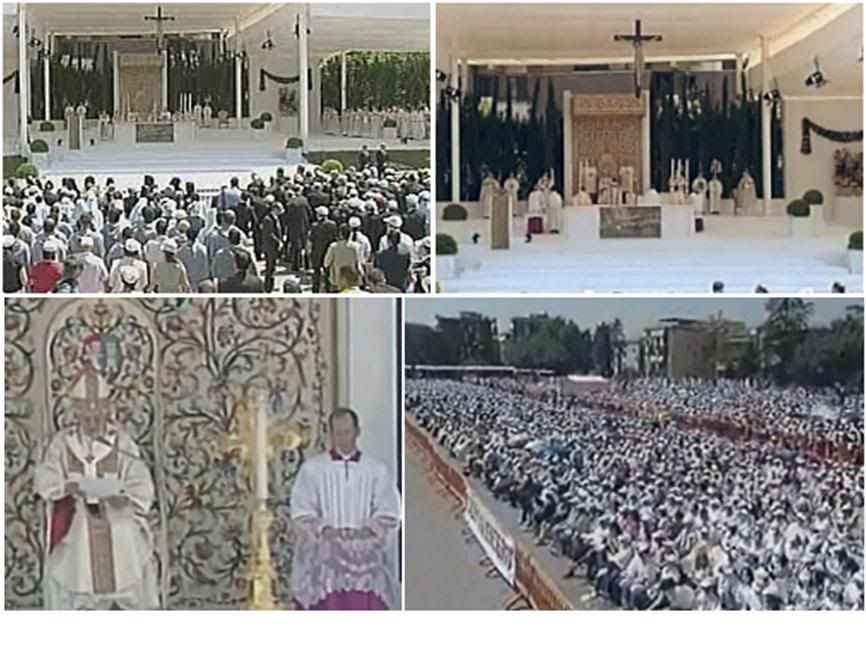 Here is a translation of the Holy Father's homily at the Mass in Cassino today (5/24)
Here is a translation of the Holy Father's homily at the Mass in Cassino today (5/24):
Dear brothers and sisters!
"You will receive power when the holy Spirit comes upon you, and you will be my witnesses in Jerusalem, throughout Judea and Samaria, and to the ends of the earth" (Acts 1,8).
With these words, Jesus bid farewell to the Apostles, as we heard in the first Reading. Shortly afterwards, the sacred author adds, "as they were looking on, he was lifted up, and a cloud took him from their sight" (Acts 1,9).
This is the mystery of the Ascension, which we solemnly celebrate today. But what do the Bible and the liturgy intend to communicate to us by saying that Jesus 'was lifted up'?
The sense of this expression can be understood not on the basis of a single text, nor even a single book of the New Testament, but in attentive listening to all of Sacred Scripture.
The word 'lift' is used in the Old Testament sense, which means installation into kingship. Thus the Ascension of Christ means, in the first place, the installation or seating of the Som of man, crucified and resurrected, in the kingship of God over the world.
There is, however, a more profound sense that is not immediately perceptible. In the pages of the Acts of the Apostles, it is said first that Jesus 'was lifted up" (v. 9), and then it is added that he was 'taken into heaven' (v. 11).
The event is described not as a voyage upward, but rather an action of God's power, which introduces Jesus into the space of proximity to the divine.
The presence of the cloud that 'took him from their sight' (v. 9) recalls a very old image of Old Testament theology, and inserts the story of the Ascension in the story of God with Israel, from the cloud on Sinai and over the tent of the Covenant in the desert, to the luminous cloud on the Mount of Transfiguration.
To present the Lord enwrapped in the clouds conclusively evokes the same mystery expressed in the symbolism of 'to sit at the right hand of God'. In the Christ who has ascended to heaven, the human being entered in an unprecedented and new way into intimacy with God - from then on, man always finds space with God.
'Heaven' does not indicate a place beyond the stars, but something much more daring and sublime - it means Christ himself, the divine Person who accompanies mankind totally and for always, him in whom God and man are forever inseparably united.
And we approach heaven, or rather, we enter heaven, to the degree that we get close to Jesus and enter into communion with him. That is why the solemnity of the Ascension invites us to a profound communion with Jesus who died and resurrected, and is invisibly present in the life of each of us.
In this perspective, we can understand why the evangelist Luke affirms that after the Ascension, the disciples returned to Jerusalem 'full of joy" (24.52). The cause of their joy was the fact that what had happened was not at all a separation. Rather, they now had the certainty that the Crucified and Risen Lord was alive, and that in him, the doors to eternal life were opened for always to mankind.
In other words, his Ascension did not mean his temporary absence from the world, but rather, it inaugurated the new, definitive and insuppressible form of his presence, by virtue of his participation in the kingly power of God.
It would fall on them, the apostles, made daring by the power of the Holy Spirit, to make this presence perceptible by their witness, by preaching and by missionary commitment.
The solemnity of the Ascension of the Lord should fill us, too, with serenity and enthusiasm, just as it did for the Apostles who left the Mount of Olives "full of joy".
Like them, we too, accepting the invitation of 'the two men dressed in white', should not remain gazing at the heavens, but rather, under the guidance of the Holy Spirit, we should go out and proclaim the salvific message of Christ's death and resurrection.
His own words, which close the Gospel according to Matthew, remain with us to comfort us: "And behold, I am with you always, until the end of time" (Mt 28, 19).
Dear brothers and sisters, the historical character of the mystery of Christ's Resurrection and Ascension helps us to recognize and understand the transcendental and eschatological condition of the Church, which was not born and does not live as a substitute for the absence of its 'departed' Lord. Rather, it finds its reason for being and its mission in the invisible presence of Jesus operating through the power of his Spirit.
In other words, we can say that the Church does not have the function of preparing for the return of an 'absent' Jesus, but on the contrary, it lives and operates in order to proclaim the 'glorious presence' in a historic and existential manner.
From the day of the Ascension, every Christian community advances its earthly itinerary towards the fulfillment of the Messianic promises, fed by the Word of God and nourished by the Body and Blood of the Lord.
This is the condition of the Church - the second Vatican Council reminds us - as it 'pursues its pilgrimage between the persecutions of the world and the consolations of God, announcing the passion and death of the Lord until he comes again" (Lumen gentium, 8).
Brothers and sisters of this beloved diocesan community, today's solemnity exhorts us to firm up anew our faith in the real presence of Jesus: without him, we cannot achieve anything effective in our life and in our apostolate.
It is he, as the Apostle Paul reminds us in the second Reading, who "gave some as apostles, others as prophets, others as evangelists, others as pastors and teachers, to equip the holy ones for the work of ministry, for building up the body of Christ", namely, the Church.
And this, in order "to attain to the unity of faith and knowledge of the Son of God", since it is the common calling of all to form "one body and one spirit, just as there is only one hope to which we are called".
It is in this light that my visit today must be seen, which, as your bishop recalled, has the purpose of encouraging you to constantly 'construct, found and rebuild' your diocesan community on Christ.
How? It is shown to us by St, Benedict himself who recommends in his Rule not to place anything ahead of Christ - "Christo nihil omnino praeponere" (LXII,11).
Thus I give thanks to God for the good that your community is realizing under the leadership of your Pastor, Father Abbot Dom Pietro Vittorelli, whom I greet with affection and whom I thank for the kind words that he addressed to me in the name of everyone.
With him I greet the monastic community, the bishops, priests, and religious present. I greet the civilian and military authorities, beginning with the Mayor whom I thank for his words of welcome upon my arrival in this Piazza Miranda - which will now carry my name, unworthy as I am of the honor.
I greet the catechists, the pastoral workers, the youth and those who in various ways attend to spreading the Gospel in this land that is so laden with history, which underwent great suffering during the Second World War.
Silent testimony to this are the many cemeteries that surround your resurrected city, among which are the Polish, the German and the Commonwealth cemeteries.
Finally, I greet all the residents of Cassino and nearby centers. To each one, especially to the sick and to the suffering, I extend assurances of my affection and prayer.
Dear brothers and sisters, we can hear resounding in our celebration the appeal of St. Benedict to keep our hearts fixed on Christ, not to put anything ahead of him. This does not distract us, but on the contrary, it impels us even more to commit ourselves to building a society in which solidarity is expressed in concrete signs.
How? Benedictine spirituality, which is well known to you, offers an evangelical program synthesized in the motto, 'Ora, labora et lege' - prayer, work, culture.
But above all prayer, which is the most beautiful legacy left by St. Benedict to his monks, and also to your local Church: to your clergy, largely formed in the diocesan seminary which for centuries was seated in the Abbey of Montecassino itself; to the seminarians; to all those who were educated in Benedictine schools and 'recreatories' and in your parishes; to all of you who live in this land.
Lifting up your eyes from every town and district in the diocese, you can all admire that constant reminder of heaven that is the monastery of Montecassino, to which you climb in procession every year on the vigil of Pentecost.
Prayer, to which every morning the bell of St. Benedict with its solemn peal calls the monks, is the silent path which leads us directly to the heart of God. It is the breath of the soul which gives us back peace in the tempest of life.
Moreover, in the school of St. Benedict, the monks have always cultivated a special love for the Word of God in lectio divina, which has now become a common patrimony for many.
I know that your diocesan Church, adapting the guidelines of the Italian bishops' conference, dedicates great attention to developing a deeper acquaintance with the Bible, and has even inaugurated an itinerary to study Sacred Scriptures, which is dedicated this year to the evangelist Mark, and which will continue over the next four years, and God willing, conclude with a pilgrimage to the Holy Land.
May careful attention to the divine Word nourish your prayers and make you prophets of truth and love in a concerted commitment to evangelization and human promotion.
Another hinge of Benedictine spirituality is work. To humanize the world of labor is typical of the spirit of monasticism, and this, too, is the effort of your Community in seeking to be at the side of the numerous workers of the major industry present in Cassino and the businesses linked to it.
I know how critical the situation is for so many workers. I express my solidarity to all who are expereincing job precariousness, to those workers who are in 'cassa integrazione' [a form of unemployment insurance that tides the worker over until he can be rehired in his old job]] or who have been dismissed outright.
May the consequences of unemployment that afflict this region lead the responsible people in public authority, the entrepreneurs and others who are in a position to do so, to find valid solutions, with the contribution of everyone, to this job crisis, creating new jobs that can help safeguard families.
In this regard, how can we not recall that the family today has an urgent need to be better protected since it is being undermined strongly in the very roots of the institution?
I think likewise of the young people who find it difficult to get worthy employment that can allow them to start a family. To them, I wish to say: Do not be discouraged, dear friends - the Church will not abandon you.
I know that at least 25 young people from your diocese took part in the last World Youth Day in Sydney. Drawing on that extraordinary spiritual experience, be the evangelical leaven among your friends and contemporaries. With the power of the Holy Spirit, be the new missionaries in this, the land of St. Benedict.
Finally, your tradition also encompasses attention to the world of culture and education. The famous Archive and Library of Montecassino
hold innumerable testimonies of the efforts of so many men and women who have meditated and studied how to improve the spiritual and material life of mankind.
In your Abbey, one can touch with the hand that 'quaerere Deum', the search for God - that is, the fact that European culture has been a search for God and a willingness to listen to him. This is valid even in our time.
I know that you have been working in this spirit in the University and in your schools so that they may be laboratories of knowledge, of research, of passion for the future of the new generations.
I also know that in preparation for my visit, you had a recent convocation on education in order to arouse in all concerned an active determination to transmit to the young those irrenunciable values of our human and Christian patrimony.
In the cultural efforts today to create a new humanism, you rightly intend, faithful to the Benedictine tradition, to emphasize attention to those who are fragile and weak, to disabled persons and to new immigrants.
And I am grateful that you are giving me the occasion to inaugurate today the Casa della Carita, where a culture solicitous of life is being built with solid reality.
Dear brothers and sisters, it is not difficult to perceive that your community, this part of the Church which lives around Montecassino, is the heir and repository of the mission, impregnated with the spirit of St. Benedict, to proclaim that in this life, no one and nothing should be in first place ahead of Christ - and that is, the mission of constructing, in the name of Christ, a new humanity concerned with harboring and helping its weakest members.
May your patriarch and patron saint, with his sister St. Scholastica, help and accompany you. And may your patron saints protect you, especially Mary, Mother of the Church and Star of our hope. Amen.

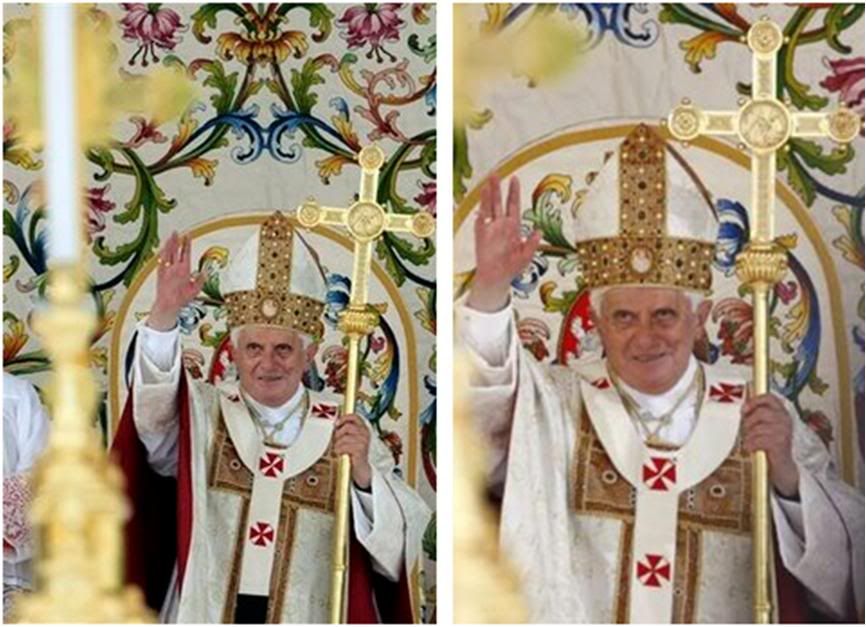 After the Mass, the Holy Father introduced the Regina Caeli prayers with these messages:
THE POPE'S MESSAGES
After the Mass, the Holy Father introduced the Regina Caeli prayers with these messages:
THE POPE'S MESSAGES
AT THE 'REGINA CAELI'
Dear brothers and sisters!
Every time we celebrate Holy Mass, we hear an necho in our hearts of the words Jesus left his disciples at the Last Supper as a precious gift: "Peace I leave with you; my peace I give to you" (Jn 14,27).
How much need the Christian community and all mankind have to taste fully the richness anx the power of Christ's peace! St. Benedict was a great witness to that, because he harbored it in his existence and he made it fruitful in works of authentic cultural adn spiritual renewal.
Because of this, the entrance to the Abbey of Montecassino and every other Benedictine monastery carries the word PAX: indeed, the monastic community is called to live in that peace which is the Paschal gift par excellence.
As you know, on my recent trip to the Holy Land, I considered myself a pilgrim for peace, and today, in ths land marked by the Beneditcitine charism, I have been given the occasion to underscore once more that peace is, in the first place, a gift from God, and therefore, its power is in prayer.
But it is a gift entrusted to human effort. The very energy necessary to realize it can be drawn from prayer. That is why it is fundamental to cultivate an authentic life of prayer to assure social progress in peace.
Once again, the history of monasticism teaches us that listening daily to the Word of God results in a great growth in civility, that it impels believers to personal and community effort to fight every form of selfishness and injustice.
By simply learning, with the grace of Christ, to fight and conquer the evil within ourselves and in our relations with others, we become authentic builders of peace and of civil progress.
May the Virgin Mary, Queen of Peace, help all Christians, in different vocations and life situations, to be witnesses to the peace that Christ has given us and left us as a demanding mission to realize everywhere.
Today, May 24, the liturgical commemoration of the Blessed Virgin Mary, Help of Christians - venerated with great devotion in the shrine of Sheshan near Shanghai - we observe the World DAy of Prayer for the Church in China.
My thoughts go to all the people of China. In particular, I greet with great affection the Catholics in China and call on them to renew on this day their communion of faith in Christ and fidelity to the Successor of Peter.
May our common prayer obtain an effusion of the gifts of the Holy Spirit so that unity among all Christians, as well as the catholicity and universality of the Church, may be ever more profound and visible.
In English, he said:
I greet the English-speaking pilgrims who have come here today to Monte Cassino.
From the heights of this mountain we contemplate with joy our risen and ascended Lord, who has taken his seat in heaven at the right hand of the Father. Where he has gone, we hope to follow.
In this place, where so many lost their lives in the battles that were fought during the Second World War, we pray especially for the souls of the fallen, commending them to God’s infinite mercy, and we pray for an end to the wars that continue to afflict our world.
May God pour out his blessings upon all of you and upon your loved ones at home.
At the end of his greeting in Italian, he said this:
On this Sunday, when we observe the World Day for Social communications, let us invoke Mary Help of Christians with filial confidence as we pray the Regina caeli.
[Modificato da TERESA BENEDETTA 25/05/2009 02:42] |
| |
 24/05/2009 21:04 24/05/2009 21:04 |
|
| | | OFFLINE | | Post: 17.517
Post: 225 | Registrato il: 28/08/2005
Registrato il: 20/01/2009 | Administratore | Utente Junior | |
|
 THE POPE IN MONTECASSINO - II
THE POPE IN MONTECASSINO - II
 At Casa della Carita
At Casa della Carita
After the Mass and Regina Caeli prayers, the Holy Father proceeded to the Casa della Carita, a project of the Benedictine Abbey with teh support of the regional government of Lazio as a hospitality center for needy persons, particularly new immigrants and newly released prisoners who have no homes.
He was greeted by Pietro Marazzo, president of Lazio Region and by Mayor Bruno Scittarelli of Cassino. The Holy Father unveiled a marker for the event then he said a prayer and blessed the center.
[No pictures of the event so far.]
But here's a most unusual picture of the Popemobile - and its illustrious passenger - navigating the climb to the Abbey.
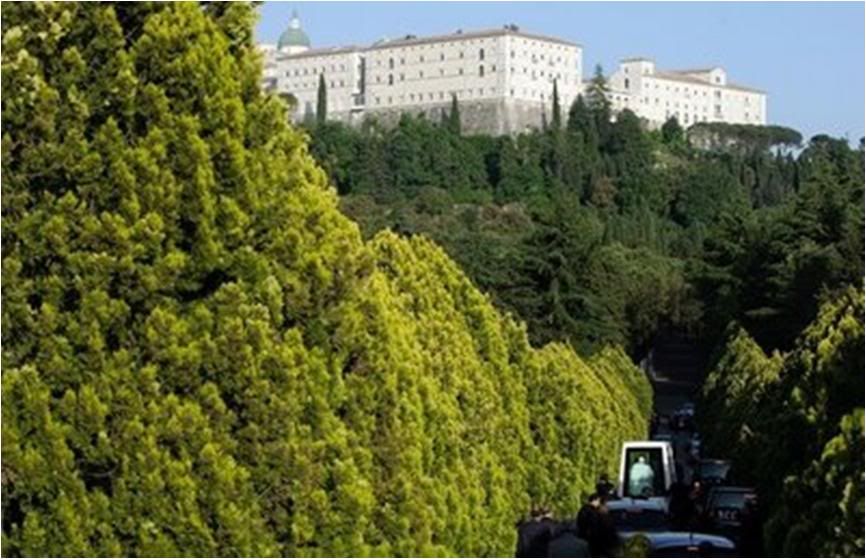 Lunch at the Abbey and
Lunch at the Abbey and
meeting with the Benedictine community
The Holy Father reached the Abbey at 1:30 and was greeted at the portal by Abbot Vittorelli with the rite of Washing the Hands according to the Rule of St. Benedict.
The Pope lunched and had a brief rest.
At 4:30, he met the monastic community of Montecassino as well as some of the organizers of the visit.
Then to the chanting of Laudes regiae, the Pope processed towards the Basilica of the Abbey for Vespers.
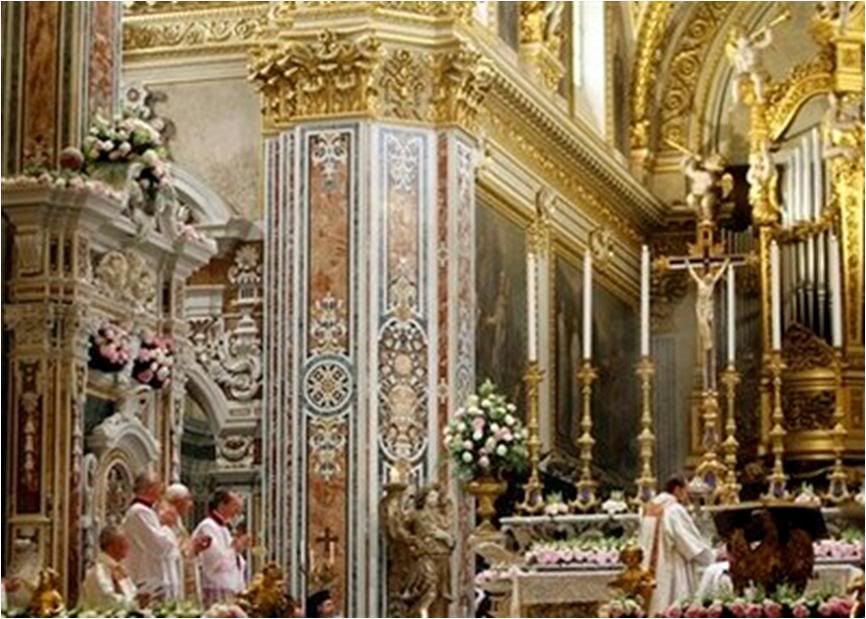 With great thanks to Caterina for her wonderful video-caps below, all the more appreciated because EWTN did not broadcast the Vespers n North America.
VESPERS AT THE ABBEY
With great thanks to Caterina for her wonderful video-caps below, all the more appreciated because EWTN did not broadcast the Vespers n North America.
VESPERS AT THE ABBEY
At 5 p.m., the Pope presided at the Celebration of Vespers with the participation of Benedictine abbots and abbesses from around the world along with the local Benedictine community.
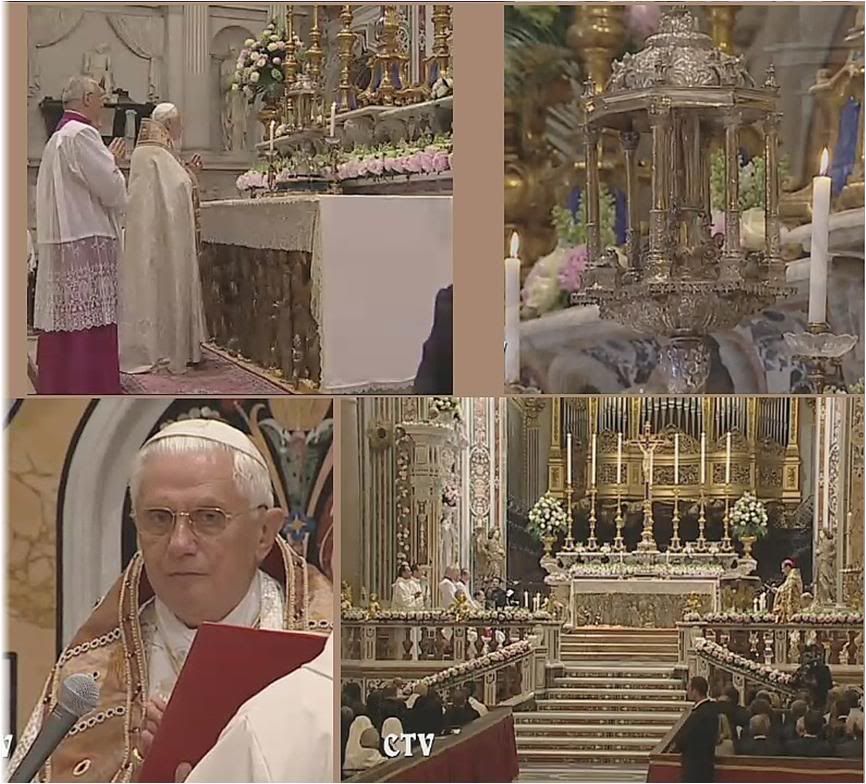
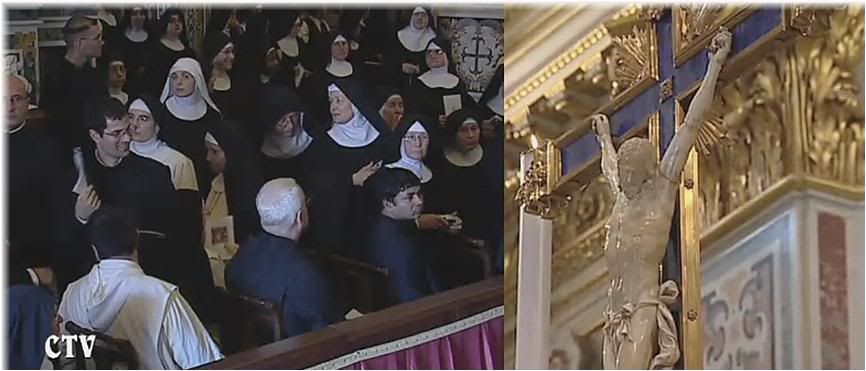
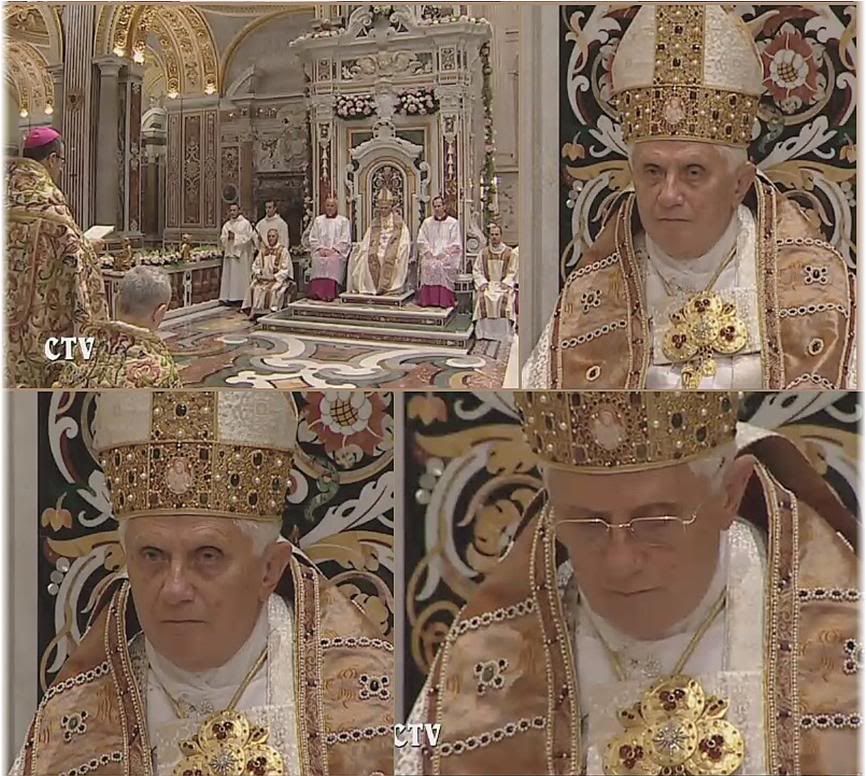
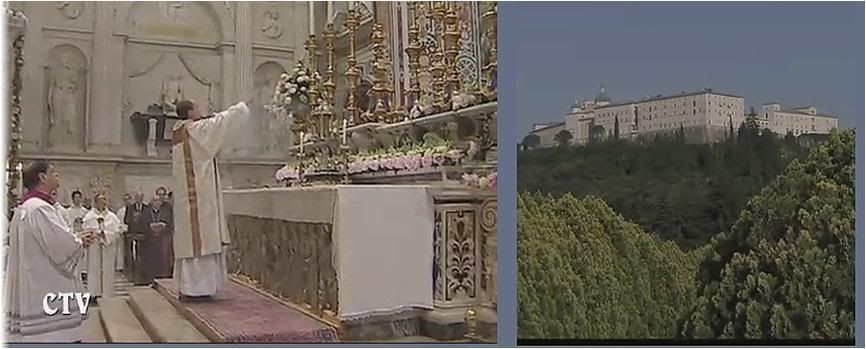
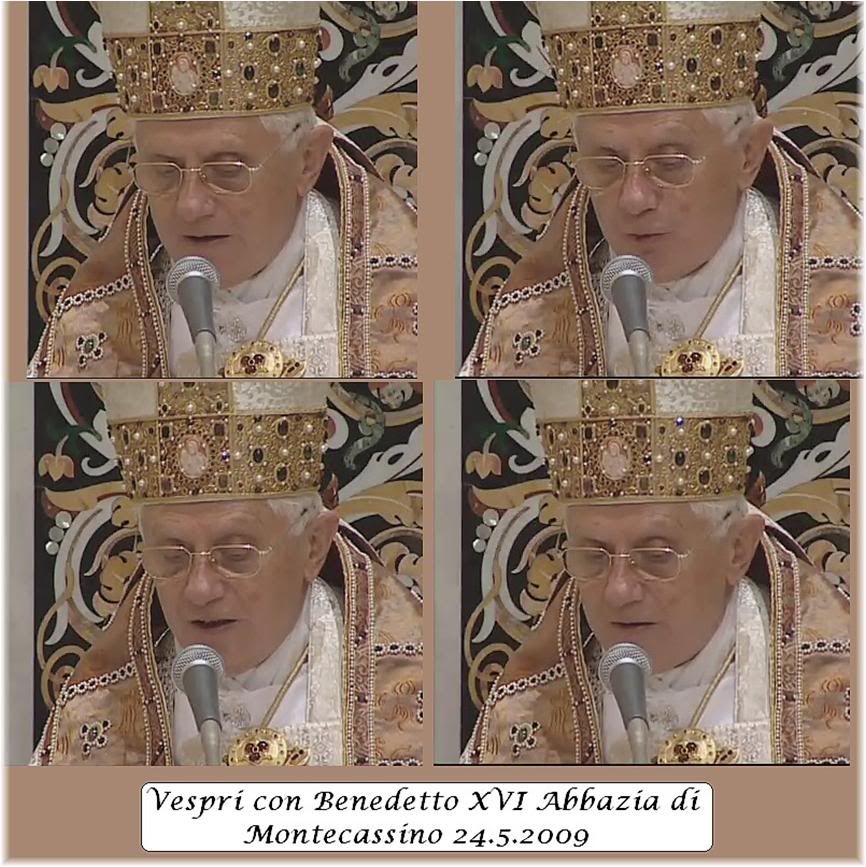 THE HOLY FATHER'S HOMILY
THE HOLY FATHER'S HOMILY
AT VESPERS
Dear brothers and sisters of the great Benedictine family!
Coming close to the end of my visit today, I am particularly pleased to be in this sacred place, in this Abbey that has deen destroyed and rebuilt four times, the last time after the bombardments of the Second World War 65 years ago.
“Succisa virescit” [When cut down, it grows again]: the words on its new coat of arms indicate its history well. Montecassino, like a centuries-old oak planted by St. Benedict, was 'stripped of leaves' by the violence of war, but rose again more vigorous than ever.
More than once I, too, had the occasion to enjoy the hospitality of the monks, and in this Abbey, I have spent unforgettable moments of quiet and prayer.
This evening, we entered here seeing the 'Laudes regiae' to celebrate Vespers together on the solemnity of the Ascension of Jesus. To each of you I express the joy of sharing this moment of prayer, greeting each of you with affection, thankful for the welcome that you have given me and those who are with me on this apostolic pilgrimage.
In particular, I greet the abbot, Dom Pietro Vittorelli, who expressed your common sentiments. I extend my greeting to the abbots, abbesses and the Benedictine communities who are present.
Today the liturgy invites us to contemplate the mystery of the Ascension of the Lord. In the brief reading taken from the First Letter of Peter, we are exhorted to fix our gaze on our Redeemer, who "died for our since once and for all" in order to lead us back to God, at whose right hand he is seated after "having gone into heaven, and is ... with angels, authorities, and powers subject to him" (1 Pt 3, 18.22).
'Lifted' and then having become invisible to the eyes of his disciples, Jesus nonetheless had not abandoned them: in fact, he was "put to death in the flesh, he was brought to life in the spirit" (1 Pt 3,18) - he is now present in a new way, interiorly in believers, and in him, salvation is offered to every human being regardless of race, language and culture.
The First Letter of Peter contains precise references to the fundamental Christological events of the Christian faith. The concern of the Apostle was to bring to light the universal importance of salvation in Christ.
We find an analogous concern in St. Paul, whose bimillennial birth anniversary we are celebrating, when he wrote to the community in Corinth: "He indeed died for all, so that those who live might no longer live for themselves but for him who for their sake died and was raised" (2 Cor 5,15).
No longer to live for oneself but for Christ: this is what gives full sense to the life of whoever allows hismelf to be conquered by him.
And this is manifested clearly in the human and spiritual experience of St. Benedict, who having abandoned everything, placed himself in a faithful following of Christ. Incarnating the Gospel in his own existence, he initiated a vast movement of spiritual and cultural rebirth in the West.
I wish to refer to an extraordinary event of his life, which his biographer St. Gregory the Great cites, and is certainly well known to you.
It can almost be said that the sainted Patriarch was 'lifted up' himself in an indescribable mystic experience. On the night of October 29, 540 - we read in the biography - while he was looking out the window "with eyes fixed on the stars as he entered into divine contemplation, the saint felt that his heart was on fire... For him, the starry firmament was like an embroidered curtain that revealed the Holy of Holies. At a certain point, his soul felt transported to the other side of the veil to contemplate openly the face of Jesus who lives within an inaccessible light" (cfr A.I. Schuster, Storia di san Benedetto e dei suoi tempi, Ed. Abbazia di Viboldone, Milano, 1965, p. 11 e ss.).
Certainly, in a way analogous to what happened to Paul after his abduction into heaven, for St. Benedict, too, after such an extraordinary spiritual experience, a new life must have begun. If the vision was fleeting, the effects remained, and his very physiognomy, his biographers say, was changed by it: his face became always serene and his manner angelic, and although he still lived on earth, it was clear his heart was alrady in Paradise.
St. Benedict received this divine gift certainly not to satisfy his intellectual curiosity, but rather so that the charism with which God had gifted him would be able to reproduce in the monastery the life of heaven itself and re-establish the harmony of creation through contemplation and work.
Rightly, then, the Church venerates him as 'the eminent master of monastic life' and 'doctor of spiritual wisdom in the love of prayer and work', 'radiant leader of peoples in the light of the Gospel' who. "raised to heaven along a luminous road", teachges men of all times to seek God and the eternal riches prepared by him (cfr Preface of the Saint in the monastic supplement to the Roman Missal, 1980, 153).
Yes, Benedict wa a luminous example of sanctity, showing his monks the one great ideal, Christ. He was a teacher of civilizwation who, proposing a balanced and adequate vision of divine exigencies and man's ultimate ends, always kept in mind the needs and reasons of the heart, in order to teach and inspire an authentic and constant fraternity, so that in the overall complex of social relations, the goal may not be lost of that spiritual unity capable of constructing and nourishing peace for always.
It is not by chance that the word PAX welcomes pilgrims and visitors at the gates of this Abbey, reconstructed after the huge disaster of teh Second World War. These gates stand like a silent reminder to reject every form of violence in order to build the peace: in families, in communities, among peoples and in the entire human family.
St. Benedict invites every person who comes up this mountain to seek peace and to follow it -“inquire pacem et sequere eam (Ps. 33,14-15)” (The Rule of St. Benedict, Prolog, 17).
In his school, monasteries have become, in the course of centuries, fervent centers of dialog, of encounter and of a beneficial fusion among different peoples, unified by the evangelical culture of peace.
The monks have always known how to teach the art of peace by word and example, realizing concretely the three 'links' that Benedict indicates as necessary to conserve the unity of the Spirit among men: the Cross, which is the law of Christ himself; the book, and therefore culture; and the plow, which signifies labor, mastery over matter and time.
Thanks to the activity of the monasteries, articulated in the triple daily commitment to prayer, study and work, entire peoples of the European continent have known authentic rescue and a beneficial moral, spiritual and cultural development, educating themselves in the sense of continuity with the past, in concrete action for the common good, in an openness to God and the transcendent dimension.
Let us pray that Europe may always know how to value this patrimony of Christian principles and ideals which constitute an immense cultural and spiritual wealth.
But this is possible only if St. Benedict's constant teaching - 'quaerere Deum', to seek God - is accepted as man's fundamental commitment.
The human being will not fully realize himself, he cannot be truly happy, without God. It falls on you in particular, dear monks, to be living examples of this interior profound relation with him, carrying out without compromises the program that your founder synthesized as
“nihil amori Christi praeponere” - do not plsce anything ahead of the love of Christ (Rule 4,21).
This is what constitutes holiness, a proposition that is valid for every Christian, more than ever in our time, when one feels the necessity of anchoring life and history on firm spiritual ground. That is why, dear brothers and sisters, your vocation is more than ever relevant, and your mission as monks indispensable.
From this place, where his mortal remains repose, the Patron Saint of Europe continues to invite everyone to follow his work of evangelization and human promotion. I encoourage you, dear monks, to remain faithful, int he first plce, to the spirit of your beginnings and to be authentic interpreters of St. Benedict's program for spiritual and social renewal.
May the Lord grant you this gift, through the itnercession of your holy founder, of his sister St. Scholastica, and all the saints of the order.
And may the heavenly Mother of the Lord, whom we invoke today as the Help of Christians, watch over you and protect this Abbey and all your monasteries, along with the diocesan community that lives around Montecassino. Amen!
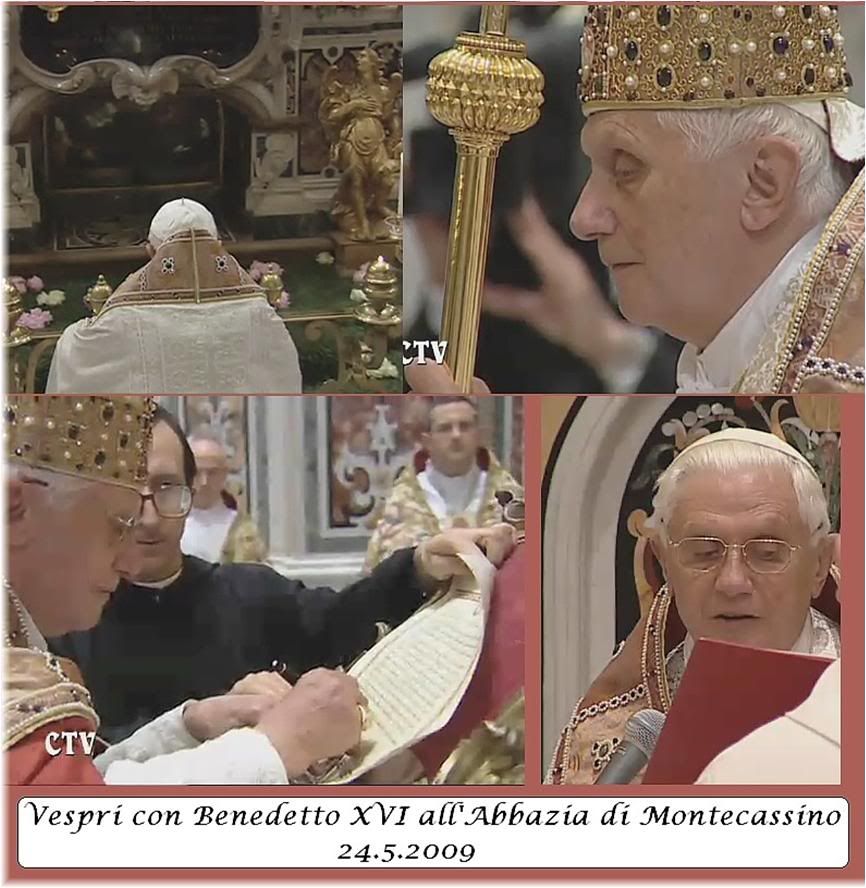
After Vespers, the Pope venerated the remains of St. Benedict and St. Scholastica who are buried behind the main altar of the Basilica.
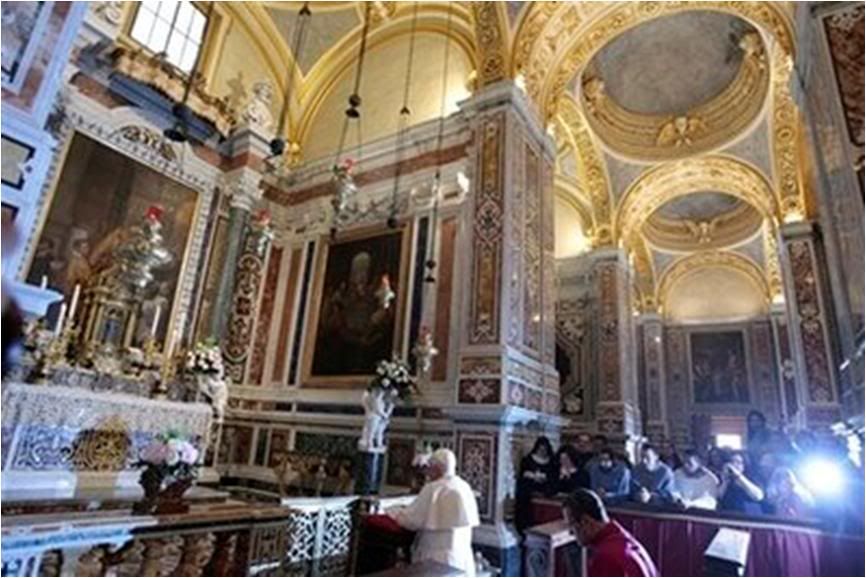 AT THE POLISH MILITARY CEMETERY
AT THE POLISH MILITARY CEMETERY
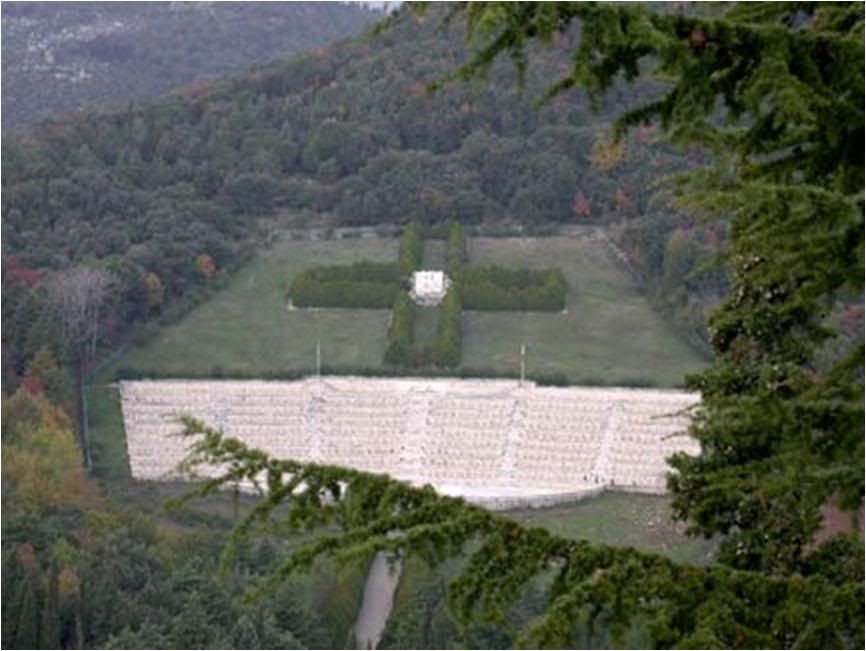 View of the Polish cemetery from the Abbey.[/C]
View of the Polish cemetery from the Abbey.[/C]
At 6 p.m., the Pope bade farewell the abbey through the so-called Loggia of Paradise to go by car to the Polish military cemetery nearby. In the central piazza, he lit a votive lamp and read a prayer for the fallen in all wars from all nations.
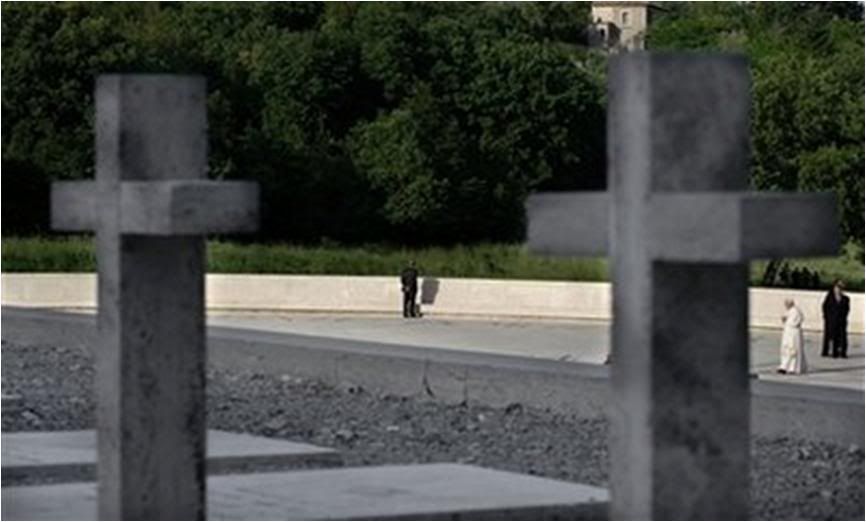

Here is a translation of the Pope's prayer:
O God, our Father,
inexhaustible source of life and peace,
welcome into your merciful embrace
thoese who fell in the war which raged here,
those who have fallen in every war
that has made the earth bloody.
Grant them to enjoy the light that never sets,
which, reflecting your radiance,
may enlighten the conscience
of every man and woman of good will.
You, who in your Son Jesus Christ
granted to suffering mankind
exalted proof of your love for us,
You who in Christ our Lord
set the sign of suffering that is never futile
but fruitful in its redeeming power -
Comfort those who suffer in the world
through the blind hate of fratricidal wars,
with the power of hope that never wanes,
the dream of a civilization of love
that is conclusively realized,
the courage for daily and real acts of peace.
Give us your Spirit Paraclete
so that men of our time may understand
that the gift of peace is more precious
than any other corruptible treasure,
and that while awaiting the day
on which the sun will never set,
we may all be called to be peacemakers
for the future of your children.
Make all Christians more convincing witnesses of life
as the inestimable gift of your love -
You who lives and reigns for ever and ever.
Amen .
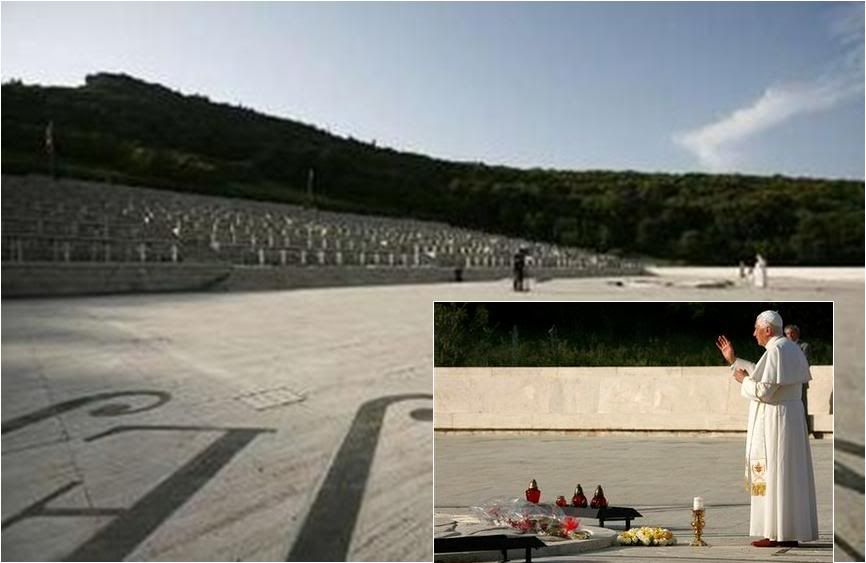
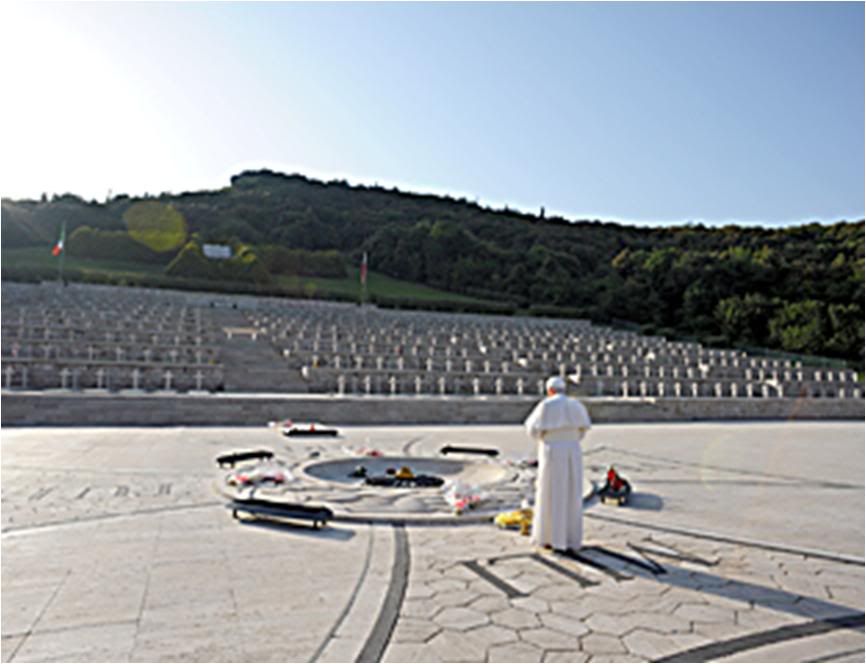
He then went back to the Peace Square of the Abbey where he bade farewell to all those who had welcomed him in the morning. He then flew back to Rome by helicopter.

5/25/09
Strangely, not enough attention has been given, even in the Italian media, to the significance of the Holy Fahter's visit and prayer at the Polish cemetery. He could have chosen to visit the German cemetery which, as he mentioned before the Regina Caeli prayer, is also in the area. But he chose to visit the resting place of the Polish soldiers who died fighting on the side of the Allies in 1944 against the German occupation forces in Italy.
Of course, his prayer was universal, for all those who have fallen in wars on any side, but not even the American wire services thought to link the Pope's gesture to Memorial Day which is observed today, the last Monday of May, in the United States and all its military cemeteries around the world.
And how very approrpaiet the Pope's prayer is for such a day of rememberance - which should not only be a pause to honor those who sacrificed their lives in war but to pray that all wars may end.
[Modificato da TERESA BENEDETTA 25/05/2009 19:07] |
| |
 25/05/2009 07:20 25/05/2009 07:20 |
|
| | | OFFLINE | | Post: 17.518
Post: 226 | Registrato il: 28/08/2005
Registrato il: 20/01/2009 | Administratore | Utente Junior | |
|
 Why Benedict XVI sees
Why Benedict XVI sees
monastic life as an example
for those of waning faith
by VITTORIO MESSORI
Translated from

May 23, 2009
Why does a Bavarian Pope in the 21st century favor a Sabine monk of the 6th century so much as to take his name and consider him the patron of his Pontificate?
Why, among all the places which have been inviting him, has he chosen to visit Montecassino for a Sunday of 'full immersion' [English term is used in the original] in the Benedictine world?
Why was it, that just the day before the death of his beloved predecessor, he went to Subiaco - where the adventure of Western monasticism began - to lecture on what could have been a program of government?
To understand such attention, one must remember that the lucid theologian, the post-modern intellectual who has become a pastor of souls, has always had - now, more than ever - an obsessive concern: aboutthe weakening of the faith, of which he is both custodian and guarantor.
A faith, he recently wrote, "that appears to be dying out like a candle that has run out of wick'. Hence, the need to rediscover the reasons for believing, to reconfirm the reasonableness pf 'wagering' on the truth of the Gospel.
The enormous ecclesial edifice hangs in the balance (St. Paul's expression) on the historicity of an empty tomb in Jerusalem. If this certainty should waver at all, then nothing will remain.
Something has been taking place for decades that was very disturbing to Joseph Ratzinger as head of the Holy Office and disturbs him even more now as Benedict XVI.
And it is the fact that what remains of a Christianity mowed down by secularism has tended to transform itself into an international association of volunteers, a socially-committed non-profit organization
The love that the Gospel urges is understood only in the horizontal sense, which means the charity of giving bread and championing socio-political commitments for a more peaceful, just and less polluted society.
This, in effect, is the 'trinitarian; slogan proposed as the new Creed by the Ecumenical Council of the Churches of Geneva: "Peace, justice, and protecting creation".
Well then, behind this clearing away of the authentic Christian perspective - which has become 'horizontal' as a consequence of its 'verticality' in looking at the things of the earth because it believes in heaven - there is a crisis of faith which is the true and tragic problem of modern Christianity.
With hope dimmed in an eternal life in the hereafter, the survivors who continue to feel 'engaged' seek pacification in working for a better life in the present, and dedicate themselves to the tangible certainties of the here and now.
Faith in man and history has replaced faith in God and eternity - and the militant for good causes has replaced the praying man and the ascetic.
Christians (but without Jesus as Christ-God! - please let us not use gross words!] as philanthropists, volunteers, labor unionists, environmentalists, custodians of human rights...
It is a disquieting deformation that in the recent past, went through the clerico-Marxist stage and which has now assumed the robes of the new hegemonic ideology - that of political correctness, of Western liberal radicalism.
What is the point in adhering to dogmas and wasting time in prayer, when there is a world which can be saved thanks to human powers, of whatever Credo or lack thereof, provided it is well intended?
This trend was a cause of anguish for Paul VI, opposed by John Paul II's extraordinary mix of mysticism and concreteness, and for Benedict XVI, the absolute priority for intervention.
All the last Popes were well aware that - through the logic of the 'et-et' ['and-and', i.e., inclusive] which has always guided the Church and the rejection of every 'aut-aut' [either-or] - Christianity is called on to humanize the City of Man, but while believing in the heavenly Jerusalem, it is mired in the world, and while it prays, it concerns itself with mortal beings insofar as they are called to immortality.
A balancing act, a synthesis, that seems to be everything. The weakening of faith has unbalanced those who, even without explicitly refuting the Credo (noisy contestation has ended out of sheer exhaustion, a sense of irrelevance, or even out of dissimulation), do not think it is necessary to their actions in any way.
And even this - or perhaps, this above all - can explain the attention that even before he became Pope, Joseph Ratzinger has always had for monastic life.
A life that is absurd, insupportable, even inhuman. A life sentence -since one chooses for life - worse than that in public prisons: a renunciation of the family, abstention from sex, no personal property, eight hours of daily communal prayer in addition to prayer by oneself, nocturnal vigils, penances, frugal vegetarian fare interrupted by frequent fasting, heat and cold, prompt and absolute obedience, prohibition from going beyond cloister walls, rare news from the outside world and what there is, filtered through one's superiors, close living together that is continuous and has no term, with companions imposed on you - a hell, in short.
But a hell that can be turned into Paradise. If, and only if, one has a vision of faith that does not hesitate about the truth of the Gospel and its promises. A Paradise only for he who believes, without a doubt, that Jesus Christ is really who the Church announces him to be.
It's a vocation for only a few, certainly. In which one manifests a total, radical faith. That does not hesitate to push to extreme consequences, and of which Montecassino has been an illustrious example for 15 centuries.
The Benedictine shows with his very life that the flame of his candle has plenty of wick. Perhaps it is this light, so rare and precious, that Benedict XVI wishes to show us believers who are increasingly unbelieving, we who have kept of the monastic dualism only the 'labora', forgetting completely about the 'ora'.
Famous monk Popes
Gregory VII
Ildebrando of Soana (ca 1020) became Pope in 1073. He clashed with the Emperor Henry IV and died after the pillage of Rome (1084).
Urban II
Urban (ca. 1040–1099) was the Prior of teh Abbey of Cluny and one of the most active supporters of the Gregorian reforms. In 1086, he became the 159th Pope.
Celestine V
As a young man, he was a monk at the benedictine monastery of Santa Maria di Falfoli. Celestine (1215-1296) is venerated as a saint adn was the only Pope who ever abdicated. [The Pope Benedict XVI visited in L'Aquila after the earthquake].
And not a Pope:
Dom Pierre Perignon
The French monk (1639-1715), who invented champagne, according to legend, was the superintendent of the Abbey of St. Pierre d'Hautvillers.
[Modificato da TERESA BENEDETTA 25/05/2009 20:33] |
| |
 25/05/2009 17:09 25/05/2009 17:09 |
|
| | | OFFLINE | | Post: 17.519
Post: 227 | Registrato il: 28/08/2005
Registrato il: 20/01/2009 | Administratore | Utente Junior | |
|

May 25
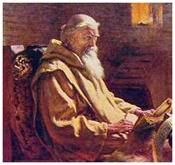 St. Bede the Venerable (England, 672-735)
St. Bede the Venerable (England, 672-735)
Doctor of the Church, Father of English history
No OR today.
THE POPE'S DAY
The Holy Father met today with
- Cardinal Giovanni Battista Re, Prefect of the Congregation for Bishops
- Cardinal Angelo Bagnasco, Archbishop of Genoa and President of the Italian bishops' conference
- Rita Levi Montalcini, Emeritus Professor of Neurobiology of the Italian Commission of National Research's
Neurobiology Institute, 1986 Nobel Prize in Medicine, and member of the Pontifical Academy of Sciences
- H.E. Bartolomej Kajtazi, Ambassador of Macedonia, on a farewell visit.
NB: In the appropriate post above, I have posted a translation of the Holy Father's homily at Vespers
in the Abbey of Montecassino yesterday.
|
| |
 25/05/2009 22:19 25/05/2009 22:19 |
|
| | | OFFLINE | | Post: 17.520
Post: 228 | Registrato il: 28/08/2005
Registrato il: 20/01/2009 | Administratore | Utente Junior | |
|
 Benedict's Europe:
Benedict's Europe:
Benedict XVI on St. Benedict
Editorial
by Mario Mauro
Vice President, Parliament of Europe, Strasbourg
Translated from

May 25, 2009
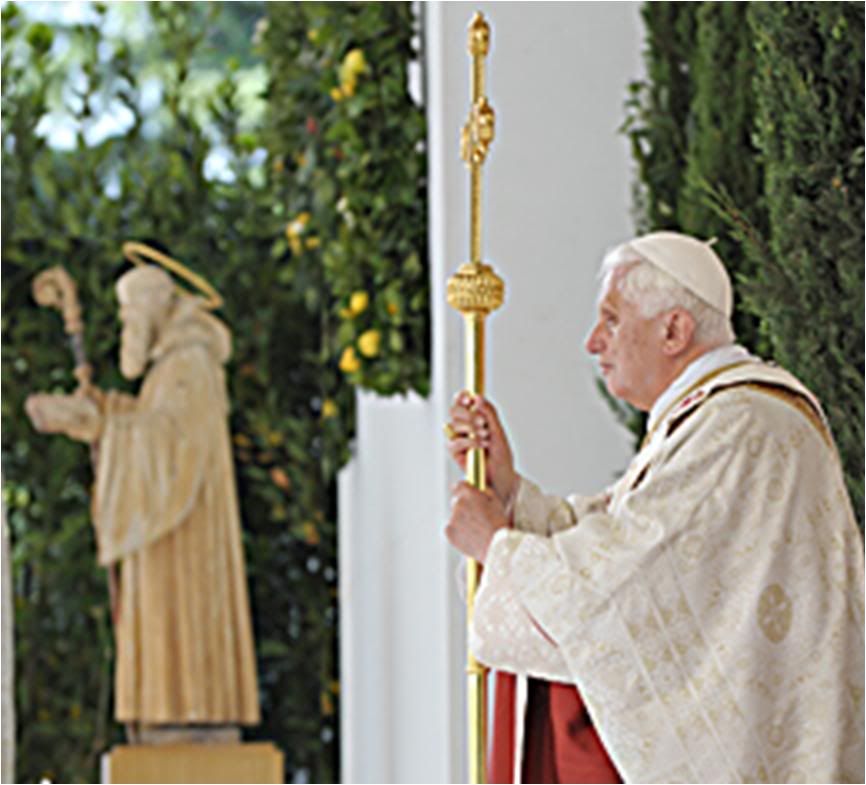
Benedict speaks about Benedict.
Four years after his famous 'Subiaco lecture' - when the then Cardinal Ratzinger presented his lectio magitralis on Europe - the Holy Father spoke again yssterday of St. Benedict of Norcia, exemplary figure and Patron Saint of Europe.
In the Abbey of Montecassino, the Pope cirted the symbols of the other Benedict - father of monasticism and proponent of evangelization on our continent - that could ideally represent today the bulwark to which our bimillennial tradition is anchored.
'Ora et labora', pray and work, the Benedictines said, and continue to say. And on this ocncept, the Pope wove a message that touches on the most relevant issues today.
Not a leab back to the past, but a lucid reflection on what is happening today. He expressed his solidarity with those who more than anyone else are paying the price imposed by the current financial crisis: those whose jobs are at risk, those who are already unemployed or have lost jobs,\, and the young people who cannot find work.
He called on responsible persons in government and in the private sector to "create new jobs and safeguard the family, which is strongly udnermined at the very roots of the institution".
Europe can find strategies to resolve the jobs emergency only if it is able to acknowledge its roots, because to create new job possibilities and overcome the present context of crisis, one must first of all fight against all forms of selfishness and seek to protect all families and young people.
St. Benedict, with a Rule made up of work, culture and prayer, contributed to bring Europe out of a period of profound crisis. The Pope has brought to our attention that this is a valid instance for dusting out a simple but effective strategy: to look at our roots and put together all the strength that we can in the same effort so that no one remains behind. [Ummmm... that's one of those well-meaning political statements that actually say nothing concrete.]
Human dignity indeed comes above all. It is for that dignity - that precisely in our continent has been trampled upon millions of times by the atrocities of ideologies - that institutions have been ready to fight for, somehow never getting the better but rather becoming their guarantors.
It is for this reason, in the memory of all the lives that wars have taken, that the Pope visited the Polish military cemetery in Montecassino, remembering all those who have fallen, from all nations and in all conflicts.
And what does all this have to do with Europe, its institutions and its citizens? Cannot faithfulness and acknowledgment of Christian roots contribute to building a Europe that is unified and fraternally solid in the search for justice and peace?
Perhaps, for those of us who have become accustomed to live in a climate devoid of civil or inter-cultural conflicts, the word 'peace' has acquired a meaning that we take for granted.
But there is a risk. If Europe is not capable of a historical memory that allows it to keep its cultural and religious tradition alive, then it cannot have a future. Shortsightedness never brings anyone far.
Europe has been truly herself and truly great in creating forms of authemtic civilization and progress for people on the universal level, only at those times when it has transmitted the constitutive values that come from the Christian faith after they had become part of the people's patrimony of culture and identity.
Unfortunately, recent history reminds us that institutions are not always capable of recognizing the progress they have made. And it is strange that Europe rejects any reference to its roots, whereas the United States, for exmaple, has never had a problem with relating to God.
Europe was born Christian and only to the degree that it remains Christian can it think of conserving its own idealism and its own original contribution to contemporary civilization.
To udnerstand this more profoundly, one must go back to the fourth century when, during the grave crisis of the Roman Empire, the Church started to develop as a new historical, cultural and political entity to reckon with.
Montecassino Abbey, which has been destroyed four times, and four times reconstructed, is the symbol of this Europe which, although it has been undermined several times at its very foundation, is still on its feet. It has survived wars, it has seen destruction, many times it has been brought to its knees, but today it is still firm and capable of assuring us and our children another 60 years of peace. It is for this reason that we should defend her in memory of St. Benedict.
The visit of Benedict XVI on the eve of an important accpintment that will involve the citizens of the 27 member states of the European Union should impel us to contineu along the path taken by the fathers of oru continent and to strive so that our young people above all may be guaranteed a future of peace and development.
[Modificato da TERESA BENEDETTA 25/05/2009 22:29] |
| |
 26/05/2009 00:28 26/05/2009 00:28 |
|
| | | OFFLINE | | Post: 17.521
Post: 229 | Registrato il: 28/08/2005
Registrato il: 20/01/2009 | Administratore | Utente Junior | |
|
 The primacy of Christ
The primacy of Christ
Editorial
by Giovanni Maria Vian
Translated from
the 5/25-5/26 issue of

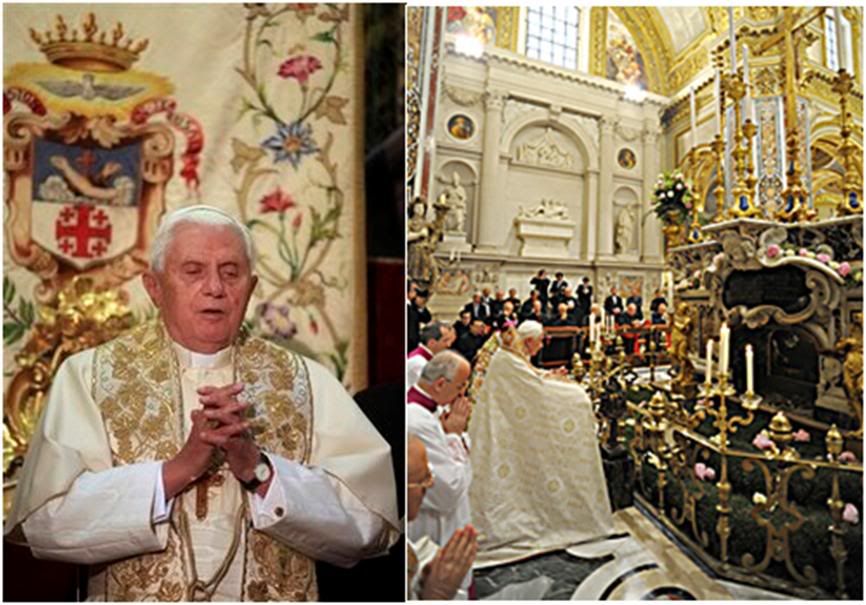
Benedict XVI returned to Montecassino, where he had been quite a few times beofre being elected to the Chair of Peter, in order to repeat yet again that nothing should be placed ahead of the love of Christ:
nihil amori Christi praeponere - according to that beautiful and essential expression of the Benedictine Rule which the new Pope in 2005 recalled to explain why he chose the name he took as the Roman Pontiff.
It is a name that augurs well, onr associated with peace, and that had not recurred in the papal succession for more than ninety years, and that the new Pope thus explained, above all, in reference to the absolute primacy of Christ.
This primacy is not an abstract concept, much less an ideology, but the consequence of an encounter - as the Pope affirms in his first encyclical - in the daily life of the Christian.
An encounter with Christ by Joseph Ratzinger, as by every other faithful believer, along the 'program' stated clearly at the start of his Pontificate: namely, "not to do my own will, not to pursue my own ideas, but to listen, together with the whole Church, to the word and the will of the Lord, to be guided by Him".
Through the search for God, that 'quaerere Deum' taught by the father of Western monasticism, and which Benedict XVI in Paris, in his memorable lecture at the College des Bernardins, had indicated as the origin of the culture that matured on the European continent.
The Benedictine program of never placing anything ahead of Christ is realized everyday in concrete acts. And in the rhythm of the monastic day, the Pope underscored, monastic life has an exemplary value for every believer, man or woman. Above all, in the space it reserves for prayer, 'the silent path' that leads to God, and therefore, a genuine 'breath for the soul".
Then comes work, a reality that is always difficult, and in this time of global crisis, a matter of concern and even anguish for individuals and families, as well as a question tied up with the issue of immigration.
And culture, which is never restricted in its areas of concern, also signifies - above all - education of the new generations and responsibility on their behalf. These are issues which, not by chance, are covered in the words today of the president of the Italian bishops conference [opening the annual general assembly of the CEI which continues till May 29].
Thus, to return to Montecassino was for Benedict XVI a fresh occasion to call attention the priorities of life. And to invoke peace yet again - rather, the gift of peace and the commitment to realize it - from a place of gentleness and civility which hadd been uselessly destroyed by the barbarism of modern wars, in that horrific tragedy with which Europe started its descent into the abyss some 70 years ago.
Because of this, Paul VI proclaimed St. Benedict, from Montecassino itself, to be the Patron of the Old Continent, symbolizing in the Cross, the plow and rteh book the centuries-long achievements of his monks. [The occasion was the inauguration of teh reconstructed Abbey in 1954.]
Thereby, he underscored the responsibility of Christians who must visibly bear witness to the profundity and efficacy of their roots. In Europe, in the global context, in the reasonable search for the common good.
[Modificato da TERESA BENEDETTA 26/05/2009 00:30] |
| |
 26/05/2009 02:00 26/05/2009 02:00 |
|
| | | OFFLINE | | Post: 17.522
Post: 230 | Registrato il: 28/08/2005
Registrato il: 20/01/2009 | Administratore | Utente Junior | |
|
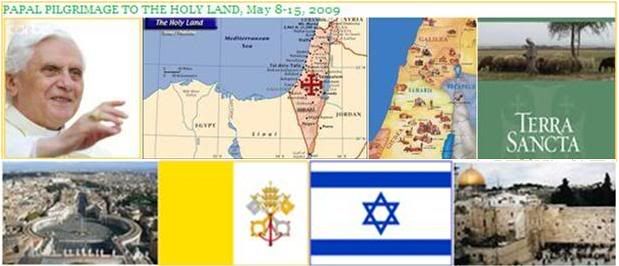 A World Jewish Ccngress news release on an event reported by the wire agencies a few days ago, praising the Pope's Israel trip, has more interesting details not reported earlier, particularly the one that has to do with Pius XII.
World Jewish Congress grateful
A World Jewish Ccngress news release on an event reported by the wire agencies a few days ago, praising the Pope's Israel trip, has more interesting details not reported earlier, particularly the one that has to do with Pius XII.
World Jewish Congress grateful
for the Pope's visit to Israel;
Cardinal Bertone invites them
to start studying open Pius XII archives

25 May 2009
During a meeting with Vatican cardinal-secretary of state, Tarcisio Bertone, in Rome, World Jewish Congress president Ronald S. Lauder has expressed gratitude for Pope Benedict’s visit to the Holy Land last week.
He said that despite being a complicated trip, its outcome had been positive and was a milestone for strengthening mutual understanding between Christians and Jews.
Lauder added that any decision or statement touching upon the sensitive issue of the Holocaust had to be made with great care. Responding to the Jewish leaders, Cardinal Bertone said the Church recognized the unique nature of the Holocaust.
Bertone also made it clear that there was no place in the institutions of the church for Holocaust deniers such as Bishop Williamson.
The cardinal-secretary of state invited the World Jewish Congress leaders and Jewish scholars to cooperate in the examination of the private archives of Pope Pius XII for the period prior to 1939, and said that the Vatican was making progress in working to have everything in place to make available Pius’s papers of the crucial period 1939 to 1945 to historians.
Ronald Lauder was accompanied by other members of the WJC Executive, including Governing Board chairman Eduardo Elsztain, treasurer Cobi Benatoff, secretary-general Michael Schneider, European Congress president Moshe Kantor, Euro-Asian Jewish Congress president Alexander Machkevitch, Latin American Jewish Congress president Jack Terpins, and WJC Israel chairman Shai Hermesh.
Cardinal Bertone said the Vatican was looking forward to further strengthening ties between Judaism and the Church. The Jewish leaders reiterated that the challenges of the future could only be tackled if inter-faith dialogue is reinforced and its benefits are well communicated to the wider world.
“We must strive together to ensure that freedom of religion is respected everywhere in the world and religion not used to justify extremism and terror,” Lauder stated.
[Modificato da TERESA BENEDETTA 26/05/2009 14:14] |
| |
 26/05/2009 14:11 26/05/2009 14:11 |
|
| | | OFFLINE | | Post: 17.524
Post: 232 | Registrato il: 28/08/2005
Registrato il: 20/01/2009 | Administratore | Utente Junior | |
|

May 26
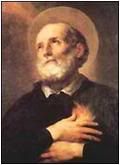 St. Filippo Neri (1515-1595)
St. Filippo Neri (1515-1595)
Founder, Congregation of the Oratory
'Apostle of Rome'
OR for 5/25-5/26.
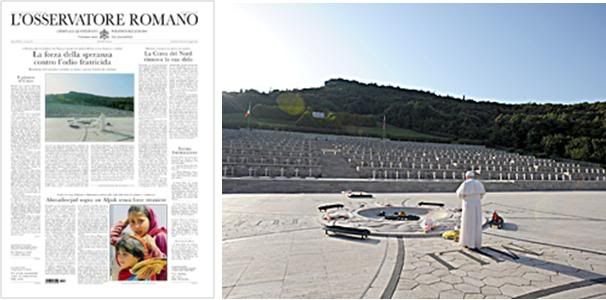
At Montecassino, the Pope prays for all who suffer from wars and violence:
'The power of hope against fratricidal hatred'
Benedict XVI remembers the Catholics in China and calls again for unity among Christians

 The issue is devoted to a full coverage of the Pope's pastoral visit to Montecassino on Sunday. Other Page 1 stories: North Korea renews its nuclear challenge; Iran's Ahmadinejad tells summit with Pakistan and Afghanistan he dreams of an Af-Pak region without the presence of foreign troops.
THE POPE'S DAY
The issue is devoted to a full coverage of the Pope's pastoral visit to Montecassino on Sunday. Other Page 1 stories: North Korea renews its nuclear challenge; Iran's Ahmadinejad tells summit with Pakistan and Afghanistan he dreams of an Af-Pak region without the presence of foreign troops.
THE POPE'S DAY
At 7:30 tonight, the Holy Father will go to the Basilica of St. John Lateran to inaugurate the annual Conference
of the Diocese of Rome to be held May 26-29 on the theme "Church affiliation and pastoral co-responsibility".
|
| |
|
|
|
|